Kindergarten To Grade 2 Lessons
Alphabet Lessons
Upper and Lowercase Letters
- Alphabet Aa, Bb, Cc
- Alphabet Dd, Ee, Ff
- Alphabet Gg, Hh, Ii
- Alphabet Jj, Kk, Ll
- Alphabet Mm, Nn, Oo
- Alphabet Pp, Qq, Rr
- Alphabet Ss, Tt, Uu, Vv
- Alphabet Ww, Xx, Yy, Zz
Uppercase Letters
- Identify Uppercase letters (ABC)
- Identify Uppercase letters (DEF)
- Identify Uppercase letters (GHI)
- Identify Uppercase letters (JKL)
- Identify Uppercase letters (MNO)
- Identify Uppercase letters (PQR)
- Identify Uppercase letters(STUV)
- Identify Uppercase letters (WXYZ)
Lowercase Letters
- Identify Lowercase letters (abc)
- Identify Lowercase letters (def)
- Identify Lowercase letters (ghi)
- Identify Lowercase letters (jkl)
- Identify Lowercase letters (mno)
- Identify Lowercase letters (pqr)
- Identify Lowercase letters (stuv)
- Identify Lowercase letters (wxyz)
Phonics Lessons
Early Birds 1
- Lesson 1: Awesome Ants
- Lesson 2: Buzzing Bees
- Lesson 3: Cute Cats
- Lesson 4: Dancing Dad
- Lesson 5: Eating Eggs
- Lesson 6: Football Fun
- Lesson 7: Grumpy Gramps
- Lesson 8: Review A - G
- Lesson 9: Happy Horses
- Lesson 10: Icy Igloo
- Lesson 11: JIggy Jello
- Lesson 12: Krazy Kangaroo
- Lesson 13: Licking Lollipops
- Lesson 14: Monster Maps
- Lesson 15: Review H - M
Early Birds 2
- Lesson 1: New Newt
- Lesson 2: Orange Octopus
- Lesson 3: Popping Popcorn
- Lesson 4: Quilted Queen
- Lesson 5: Racing Rabbit
- Lesson 6: Seven Seas
- Lesson 7: Tent Trick
- Lesson 8: Review N - T
- Lesson 9: Umbrella Up
- Lesson 10: Visiting Vet
- Lesson 11: Wishing Well
- Lesson 12: Foxes in Boxes
- Lesson 13: Yellow Yo-yo
- Lesson 14: Zig Zag Zebras
- Lesson 15: Review U - Z
Letter Sounds
- Letter sounds: ABC
- Letter sounds: DEF
- Review: ABCDEF
- Letter sounds: GHI
- Letter sounds: JKL
- Review: GHIJKL
- Letter sounds: MNO
- Letter sounds: PQR
- Review MNOPQR
- Letter sounds: STUV
- Letter sounds: WXYZ
- Review STUVWXYZ
Letter Sounds
- Short Vowel A
- Short Vowel E
- Short Vowel I
- Short Vowel O
- Short Vowel U
- Short Vowel Review
Vocabulary Lessons
- Food 1
- Food 2
- Animals 1
- Animals 2
- Body Parts 1
- Body Parts 2
- Home 1
- Home 2
- Home 3
- Actions 5
- Actions 6
- Jobs 1
- Jobs 2
- School 1
- School 2
- Clothes 1
- Clothes 2
- Fruit 1
- Fruit 2
- Vegetables 1
- Vegetables 2
- Months 1
- Months 2
- Ocean Animals 1
- Ocean Animals 2
- Farm 1
- Farm 2
- Weather 1
- Feelings 1
- Feelings 2
- Numbers 1
- Numbers 2
- Sports 1
- Numers 1
- Numbers 2
- Feelings 1
- Feelings 2
Grades 3 and 4 Lessons
Functional Language
Runway 1
- Lesson 1: What's Your Name
- Lesson 2: It's His Face
- Lesson 3: It’s My Toe
- Lesson 4: I like dogs
- Lesson 5: I Like Yellow
- Lesson 6: I Like Frogs
- Lesson 7: The Hat is Blue
- Lesson 8: Do You Like Red?
- Lesson 9: There Are Two
- Lesson 10: It’s a Man
Runway 2
- Lesson 1: I Can Sit
- Lesson 2: The Big Dog
- Lesson 3: Do You Want?
- Lesson 4: Party Activities
- Lesson 5: Let's Eat
- Lesson 6: Fruit Store
- Lesson 7: How Old?
- Lesson 8: So Many
- Lesson 9: Where is Karen?
- Lesson 10: In the Kitchen
Runway 3
- Lesson 1: The pink Kettle
- Lesson 2: I play tennis
- Lesson 3: I have a pen
- Lesson 4: Can you draw?
- Lesson 5: Going to see
- Lesson 6: I can swim
- Lesson 7: I see green
- Lesson 8: Where are you?
- Lesson 9: Go outside
- Lesson 10: I go home
Runway 4
- Lesson 1: Who is She?
- Lesson 2: How Do You Feel?
- Lesson 3: It's My Nose
- Lesson 4: Where's the Cow?
- Lesson 5: What color is it?
- Lesson 6: I Like Monkeys
- Lesson 7: Which Do You Like?
- Lesson 8: What Color Are They
- Lesson 9: There are Three
- Lesson 10: What do you see?
Runway 5
- Lesson 1: How is He?
- Lesson 2: Who is She?
- Lesson 3: I Like to Eat Meat
- Lesson 4: Do You Like to Eat?
- Lesson 5: Like for Lunch
- Lesson 6: How Old is He?
- Lesson 7: Many Blue Dogs
- Lesson 8: 3 Oranges
- Lesson 9: Where's the Cat?
- Lesson 10: What is She Doing?
Runway 6
- Lesson 1: The Ball is on the Bed
- Lesson 2: Open Your Book
- Lesson 3: They're Blue
- Lesson 4: Who is That?
- Lesson 5: Favorite Color
- Lesson 6: Kick a Ball
- Lesson 7: I Like Tennis
- Lesson 8: When Did You?
- Lesson 9: How Did You?
- Lesson 10: Where is Kevin
Runway 7
- Lesson 1: Hello, how are you
- Lesson 2: What's your name?
- Lesson 3: The Alphabet
- Lesson 4: Numbers
- Lesson 5: Colors
- Lesson 6: Can you help me please?
- Lesson 7: Toys
- Lesson 8: Big and Small
- Lesson 9: Family
- Lesson 10: Family and Friends
Runway 8
- Lesson 1: I Love My Pets
- Lesson 2: I Love Colours
- Lesson 3: Look At Me
- Lesson 4: I'm Happy Today
- Lesson 5: It's a Fashion Show
- Lesson 6: This is Me
- Lesson 7: I Like Fruit
- Lesson 8: What's Your Favourite Food?
- Lesson 9: Are You Ready For School ?
- Lesson 10: Stand Up
Runway 9
- Lesson 1: The Apple Tree
- Lesson 2: Look At My Garden
- Lesson 3: Photo Fun
- Lesson 4: She Can Sing
- Lesson 5: It's Party Time
- Lesson 6: She Likes Chocolate
- Lesson 7: Let's go to the Zoo
- Lesson 8: Smile Crocodile
- Lesson 9: At Home
- Lesson 10: Where is Ziggy?
Runway 10
- Lesson 1: Where's Mr Clarke?
- Lesson 2: Your Classroom
- Lesson 3: On The Farm
- Lesson 4: It Can Fly!
- Lesson 5: Photos of My Family
- Lesson 6: We Love Fashion!
- Lesson 7: At The Restaurant
- Lesson 8: Time For Lunch
- Lesson 9: Where Are My Friends?
- Lesson 10: The Big Red Bus
Runway 11
- Lesson 1: Let's Make a Smoothie
- Lesson 2: Welcome to My shop
- Lesson 3: Looking At The Animals
- Lesson 4: Animals All Around
- Lesson 5: My Mobile Phone
- Lessn 6: Hurry Up! Time To Go!
- Lesson 7: Books Are Cool!
- Lesson 8: There's A Monster
- Lesson 9: Hobbies
- Lesson 10: We Like Playing Sports
Runway 12
- Lesson 1: It's the Weekend
- Lesson 2: Time to Do Your Chores
- Lesson 3: What Does She Do EveryDay?
- Lesson 4: My Dad's Daily Routine
- Lesson 5: On The Beach
- Lesson 6: The sea is Nice and Blue
- Lesson 7: On My Street
- Lesson 8: They are Sitting in The Sun
Grammar
Nouns
- Nouns that Name People
- Nouns that Name Places
- Nouns that Name Things
- Identify Nouns
- Identify Nouns in a Sentence
- Choose a common noun
- Identify the Type of Noun
Singular and Plural Nouns
- Identify Singular nouns
- Identify Singular Nouns in a Sentence
- Identify Plural Nouns
- Identify the Plural noun in a sentence
- Choose Between Singular and Plural Nouns in Context
- Change Singular Nouns into Plural Nouns with -s
- Convert Singular Nouns to Plural Nouns by Adding -es
- Convert Singular Nouns that end in a Consonant and y to Plural Nouns
- Change Singular Nouns Ending in a Vowel and y to Plural Nouns
Proper Nouns
- Identify Proper Nouns that name People
- Identify Proper Nouns that name Places
- Identify Proper Nouns that name Days and Months
- Identify Proper Nouns that name Holidays
- Identify Proper Nouns
- Identify Proper Nouns in a Sentence
- Capitalize Proper Nouns
- Differentiate Between Common and Proper Nouns
Possessive Noun
- Identify Possessive Nouns
- Recognize the Correctly Used Possessive
- Form Singular Possessive Nouns
Verbs
- Identify Action Verbs in a Sentence
- Identify Action Verbs
- Choose an Appropriate Action Verb to Complete a Sentence
- Identify the Present Tense
- Identify the Past Tense
- Choose Verbs for the Recent and Distant Past
- Form Regular Past Tense Verbs
- Identify Irregular Past Tense Verbs
- Identify the Future Tense
- Use Verbs for the Near and Distant Future
- Identify the Verb Tense
- Use the correct verb tense
Determiners
- Identify articles
- Use the articles "a" and "an"
- Use demonstratives (this, these)
- Use demonstratives (that, those)
- Use demonstratives (this, that, these, those)
- Use quantifiers
Possessive Pronouns
- Understand Possessive Nouns
- Identify possessive pronouns (her, his, their, its)
- Use possessive pronouns (her, his, their, its)
- Replace possessive nouns with possessive pronouns
Adjectives
- Identify adjectives(looks, tastes, sounds, smells, and textures)
- identify color and number adjectives
- Identify adjectives that describe emotions and character traits
- Identify adjectives in a Sentence
- determine the function of an adjective
- Analyze the function of an adjective
- Use adjectives to describe people, places, and things
- use adjectives to describe emotions and character traits
- use comparatives and superlatives
Conjunctions
- Use conjunctions (and, or, but)
- Use Conjunctions (because, so)
- Choose an Appropriate Conjunction to Complete a Sentence
- Join Compound Subjects by Using "and"
- Join Compound Predicates by Using "and"
- Join Adjectives by Using "and"
Personal Pronouns
- Identify Personal Subject Pronouns
- Identify Personal Object Pronouns
- Select Appropriate Personal Pronouns (he, she, it, they)
- Use Personal Pronouns
- Differentiate Between the Personal Pronouns "I" and "me"
- Differentiate Between the Personal Pronouns "she" and "her"
- Differentiate Between the Personal Pronouns "he" and "him"
- Differentiate Between the Personal Pronouns "they" and "them"
- Differentiate Between the Personal Pronouns "we" and "us"
Prepositions
- Identify Prepositions that Tell Where
- Identify Prepositions that Tell When
- Identify Prepositions that Tell How or Why
- Use Prepositions that Tell Where
- Use Prepositions that Tell When
- Use Prepositions that Tell How or Why
Indefinite Pronouns
- Indefinite Pronouns (everything, something, anything, nothing)
- Use Indefinite Pronouns (everyone, someone, anyone, no one)
Subject Verb Agreement with Nouns
- Identify Regular Verbs with Plural Nouns
- Identify Regular Verbs with Singular Nouns
- Use Singular Nouns with Regular Verbs
- Use Plural Nouns with Plural Verbs
- Use "to be" and "to have" with Singular Nouns
- Use "to be" and "to have" with Plural Nouns
- use Singular Nouns with "to be" and "to have"
- Use Singular and Plural Nouns with "to be" (Past tense)
Subject Verb Agreement with Pronouns
- Use Verbs with the Pronouns (he, she, it)
- Use Pronouns (he, she, and it) with Regular Verbs
- Use Regular Verbs with Plural Pronouns (we, they)
- Use Plural Pronouns (we, they) with Regular Verbs
- Use Regular Verbs with Pronouns (I, you)
- Use Pronouns (I, you) with Regular Verbs
- Use "to be" and "to have" with Singular Pronouns (he, she, it)
- Use Singular Pronouns (he, she, it) with "to be" and "to have"
- Use "to be" and "to have" with Plural Pronouns (we, they)
- Pronouns (we, they) with "to be" and "to have"
- Use "to be" and "to have" with Plural Pronouns (I, you)
- Use The pronouns (I, you) with "to be" and "to have"
- use "to be" with Pronouns in the Past Tense
Math
Money
- Count Money Up to a Dollar
- Count Money Up to a Dollar Word Problems
- Count money up to 5 dollars
- Count Money up to Five Dollars Word Problems
Time
- Understand minutes and hours on a digital clock
- Read a digital clock
- Write time in digital form
- Use 5 blocks to tell minutes on an analog clock
- Tell the minutes on an analog clock
- Tell the hours on an analog clock
- Tell time with an analog clock
Time
- See Hundreds as a Group of Tens and Ones
- Skip Count by 5s with Manipulatives
- Skip count by 5s from multiples of 5
- Skip Count by 10s with Manipulatives
- Skip count by 10s from multiples of 10
- Skip Count by 100s with Manipulatives
- Skip count by 100s from multiples of 100
Place Value Notations: 1s 10s 100s
- Identify Place Value
- Convert a Number into a Sum of Place Values
- Convert a sum of place values into a number
- Write the Amount of Given Blocks: 1s, 10s, 100s
- Write Numbers Less Than 1000 in Expanded Form
- Write number with words
- Translate Numbers to Number Names and Expanded Form
Comparng 3-digit numbers
- Compare 3-digit Numbers
- Identify Equivalent Inequalities
- Sort 3-digit Numbers
- Sort Three-digit Numbers 2
Odd Even
- Determine Odd or Even by Splitting into Two Groups
- Write Even Numbers as a Sum of Two Equal Addends
- Identify Even or Odd Numbers
- Use Even and Odd numbers in Groups
Subtracting with Unknowns
- Use a number line to subtract two knowns
- Use a number line to subtract an unknown number from a known number
- Use a number line to subtract an known number from an unknown number
- Use a number line to subtract knowns and unknowns using a number line
- Subtract a known from an unknown using a number line word problem
- Subtract an unknown then a known from a known word problems
Measuring Length
- Measure Using a Ruler or Table
- Compare Inches and Centimeters
Comparing lengths
- compare measurements word problems
- compare measurements word problems
Estimating lengths
- estimate length in inches
- estimate length in feet
- estimate length in centimeters
- estimate length in meters
- estimate length with different units
Shapes
- Recognize shapes
- Identify Images of shapes given distinguishing features
- Name shapes given distinguishing features and an image
- Name shapes given distinguishing features
- identify number of faces on a cube
- identify faces of solid shapes
- identify edges and vertices of solid shapes
Grades 4 and 5 Lessons
Functional Language
Lift Off 1
- Lesson 1: Who is the Boy?
- Lesson 2: What is Kevin Like?
- Lesson 3: What Do You Do?
- Lesson 4: What's Your Father Like?
- Lesson 5: Is He Lazy?
- Lesson 6: How is the Cake?
- Lesson 7: How Many Apples?
- Lesson 8: More Apples
- Lesson 9: More Than
- Lesson 10: What's the Matter?
Lift Off 2
- Lesson 1: What Happened?
- Lesson 2: How Bad?
- Lesson 3: To the Park
- Lesson 4: Watch a Movie
- Lesson 5: I Love Bees
- Lesson 6: Go Camping
- Lesson 7: To the Beach
- Lesson 8: Winter Sports
- Lesson 9: Twelve Noon
- Lesson 10: Wake Up
Lift Off 3
- Lesson 2: In the Winter
- Lesson 3: Sunny and Hot
- Lesson 4: Snowy Blizzard
- Lesson 5: Bare Tree
- Lesson 6: Help My Mom
- Lesson 7: Finished Homework
- Lesson 8: What's He Doing?
- Lesson 9: Camping Trip
- Lesson 10: On the Weekend
Lift Off 4
- Lesson 1: Where is It?
- Lesson 2: How Often?
- Lesson 3: Which Do You Prefer?
- Lesson 4: Why is He?
- Lesson 5: What Would You Like?
- Lesson 6: What to Do?
- Lesson 7: Tens and Ones
- Lesson 8: One Plus One
- Lesson 9: The Sum Total
- Lesson 10: Like to Be
Lift Off 5
- Lesson 1: What Do They Do?
- Lesson 2: How Do You Feel?
- Lesson 3: Movie Night
- Lesson 4: Tie My Laces
- Lesson 5: Take Some Popcorn
- Lesson 6: Furry Rabbits
- Lesson 7: The Countryside
- Lesson 8: Beach Activities
- Lesson 9: Weather on Monday
- Lesson 10: My Busy Week
Lift Off 6
- Lesson 1: Time for Class
- Lesson 2: The Best Weather
- Lesson 3: What to Wear
- Lesson 4: Stormy Weather
- Lesson 5: Where in Town?
- Lesson 6: Watch a Movie
- Lesson 7: Find a Game
- Lesson 8: Granny's Farm
- Lesson 9: At the Beach
- Lesson 10: Seeing Animals
Grammar
Nouns
- Nouns that Name People
- Nouns that Name Places
- Nouns that Name Things
- Identify Nouns
- Identify Nouns in a Sentence
- Choose a common noun
- Identify the Type of Noun
Singular and Plural Nouns
- Identify Singular nouns
- Identify Singular Nouns in a Sentence
- Identify Plural Nouns
- Identify the Plural noun in a sentence
- Choose Between Singular and Plural Nouns in Context
- Change Singular Nouns into Plural Nouns with -s
- Convert Singular Nouns to Plural Nouns by Adding -es
- Convert Singular Nouns that end in a Consonant and y to Plural Nouns
- Change Singular Nouns Ending in a Vowel and y to Plural Nouns
Proper Nouns
- Identify Proper Nouns that name People
- Identify Proper Nouns that name Places
- Identify Proper Nouns that name Days and Months
- Identify Proper Nouns that name Holidays
- Identify Proper Nouns
- Identify Proper Nouns in a Sentence
- Capitalize Proper Nouns
- Differentiate Between Common and Proper Nouns
Possessive Noun
- Identify Possessive Nouns
- Recognize the Correctly Used Possessive
- Form Singular Possessive Nouns
Verbs
- Identify Action Verbs in a Sentence
- Identify Action Verbs
- Choose an Appropriate Action Verb to Complete a Sentence
- Identify the Present Tense
- Identify the Past Tense
- Choose Verbs for the Recent and Distant Past
- Form Regular Past Tense Verbs
- Identify Irregular Past Tense Verbs
- Identify the Future Tense
- Use Verbs for the Near and Distant Future
- Identify the Verb Tense
- Use the correct verb tense
Determiners
- Identify articles
- Use the articles "a" and "an"
- Use demonstratives (this, these)
- Use demonstratives (that, those)
- Use demonstratives (this, that, these, those)
- Use quantifiers
Possessive Pronouns
- Understand Possessive Nouns
- Identify possessive pronouns (her, his, their, its)
- Use possessive pronouns (her, his, their, its)
- Replace possessive nouns with possessive pronouns
Adjectives
- Identify adjectives(looks, tastes, sounds, smells, and textures)
- identify color and number adjectives
- Identify adjectives that describe emotions and character traits
- Identify adjectives in a Sentence
- determine the function of an adjective
- Analyze the function of an adjective
- Use adjectives to describe people, places, and things
- use adjectives to describe emotions and character traits
- use comparatives and superlatives
Conjunctions
- Use conjunctions (and, or, but)
- Use Conjunctions (because, so)
- Choose an Appropriate Conjunction to Complete a Sentence
- Join Compound Subjects by Using "and"
- Join Compound Predicates by Using "and"
- Join Adjectives by Using "and"
Personal Pronouns
- Identify Personal Subject Pronouns
- Identify Personal Object Pronouns
- Select Appropriate Personal Pronouns (he, she, it, they)
- Use Personal Pronouns
- Differentiate Between the Personal Pronouns "I" and "me"
- Differentiate Between the Personal Pronouns "she" and "her"
- Differentiate Between the Personal Pronouns "he" and "him"
- Differentiate Between the Personal Pronouns "they" and "them"
- Differentiate Between the Personal Pronouns "we" and "us"
Prepositions
- Identify Prepositions that Tell Where
- Identify Prepositions that Tell When
- Identify Prepositions that Tell How or Why
- Use Prepositions that Tell Where
- Use Prepositions that Tell When
- Use Prepositions that Tell How or Why
Indefinite Pronouns
- Indefinite Pronouns (everything, something, anything, nothing)
- Use Indefinite Pronouns (everyone, someone, anyone, no one)
Subject Verb Agreement with Nouns
- Identify Regular Verbs with Plural Nouns
- Identify Regular Verbs with Singular Nouns
- Use Singular Nouns with Regular Verbs
- Use Plural Nouns with Plural Verbs
- Use "to be" and "to have" with Singular Nouns
- Use "to be" and "to have" with Plural Nouns
- use Singular Nouns with "to be" and "to have"
- Use Singular and Plural Nouns with "to be" (Past tense)
Subject Verb Agreement with Pronouns
- Use Verbs with the Pronouns (he, she, it)
- Use Pronouns (he, she, and it) with Regular Verbs
- Use Regular Verbs with Plural Pronouns (we, they)
- Use Plural Pronouns (we, they) with Regular Verbs
- Use Regular Verbs with Pronouns (I, you)
- Use Pronouns (I, you) with Regular Verbs
- Use "to be" and "to have" with Singular Pronouns (he, she, it)
- Use Singular Pronouns (he, she, it) with "to be" and "to have"
- Use "to be" and "to have" with Plural Pronouns (we, they)
- Pronouns (we, they) with "to be" and "to have"
- Use "to be" and "to have" with Plural Pronouns (I, you)
- Use The pronouns (I, you) with "to be" and "to have"
- use "to be" with Pronouns in the Past Tense
Math
Multiplying by 1
Grammar - 30 Lessons
- Use the rule of 1
- Use groups of 1
- Multiply by 1 Word Problems
Multiply by 2
- Multiply with Groups of 2
- Use the Rule of 2
- Multiply by 2
- Multiply by 2 with Unknowns
- Multiply by 2 Word Problems
Multiply by 3
- Multiply by 3
- Multiply by 3 with unknowns
- Multiply by 3 wordproblems
- Use groups of 3
Multiply by 4
- Multiply by 4
- Multiply by 4 with unknowns
- Multiply by 4 with word problems
- Use groups of 4
Multiply by 0
- Use the Rule of 0
- Multiply by 0 word problems
Divide by 1
- Rule of 1
- Divide by 1 Unknown
- Divide by 1 Word Problems
Multiplication
- Multiply One-digit by Two-digits with Expanded Form
- Multiply One-Digit by Three-digits with Expanded Form
- Multiply one-digit times three-digits with partial product algorithm
Fractions
- Add fractions with same denominators
- Subtract fractions with same denominators
- Solve equivvalent fraction word problems
- Compare fractions word problems
- Multiply a fraction by a whole number word problems part 1
Decimal numbers
- Convert decimals to fractions word problems
- Compare decimal word problems
Division
- Divide a 3-Digit Number by a 2-Digit Divisor
- Divide a 4-Digit Number by a 2-Digit Divisor
- Divide and Check Your Answer
Decimal numbers
- Read and write decimals
- Compare decimal numbers word problems
- Convert decimals to fractions word problems
- Use place value with expanded notation
- Write decimal numbers with expanded notation
- Multiply decimals word problems
- Divide decimals word problems
Ratios
- Identify Ratios
- Identify Ratios Word Problems
- Solve for Unknown in Equivalent Ratios from a Table
Fractions
- Divide two fractions
- Divide mixed numbers
Ordering and Absolute Value
- Compare two positive integers on a number line
- Compare negative and positive Integers on a number line
- Compare two negative numbers on a number line
- Write statements of order for rational numbers in real-world contexts
Testing Lessons
Testing
Eiken Tests
Eiken Question Banks
- Grade 5: Reading
- Grade 5: Listening
- Grade 5: Speaking
- Grade 4: Sample
- Grade 4: Listening
- Grade 4: Speaking
- Grade 3: Reading
- Grade 3: Writing
- Grade 3: Listening
- Grade 3: Speaking
- Grade Pre-2: Reading
- Grade Pre-2: Listening
- Grade Pre-2: Writing
- Grade Pre-2: Speaking
CEFR Tests
- Multi Skill Adaptive Set
- Writing Adaptive Set
- Speaking Adaptive Set
- Reading Adaptive Set
- Listening Adaptive Set
- Multi Skil Linear - A1
- Multi Skil Linear - A2
- Multi Skil Linear - B1
- Multi Skil Linear - B2
- Reading Linear Set - A1
- Listening Linear Set - A1
- Speaking Linear Set - A1
- Writing Linear Set - A1
- Reading Linear Set - A2
- Listening Linear Set - A2
- Speaking Linear Set - A2
- Reading Linear Set - B1
- Listening Linear Set - B1
- Speaking Linear Set - B1
- Reading Linear Set - B2
- Listening Linear Set - B2
- Speaking Linear Set - B2
Travel English Lessons
Travel
Boston
- Chapter 1: Homestay
- Chapter 2: School Visit
- Chapter 3: Transportation in Boston
- Chapter 4: Shopping in Boston
- Chapter 5: Restaurant
- Chapter 6: Museum
- Chapter 7: Small Talk
- Chapter 8: To Do List
Singapore
- Chapter 1: Homestay
- Chapter 2: School Visit
- Chapter 3: Transportation in Singapore
- Chapter 4: Shopping in Singapore
- Chapter 5: Restaurant
- Chapter 6: Museum
- Chapter 7: Small Talk
- Chapter 8: To Do List
Sydney
- Chapter 1: Homestay
- Chapter 2: School Visit
- Chapter 3: Transportation in Sydney
- Chapter 4: Shopping in Sydney
- Chapter 5: Restaurant
- Chapter 6: Museum
- Chapter 7: Small Talk
- Chapter 8: To Do List
Vancouver
- Chapter 1: Homestay
- Chapter 2: School Visit
- Chapter 3: Transportation in Vancouver
- Chapter 4: Shopping in Vancouver
- Chapter 5: Restaurant
- Chapter 6: Museum
- Chapter 7: Small Talk
- Chapter 8: To Do List
Adult English Lessons
Adult
Business
Business Corner 1
- Lesson 1: Meeting New People
- Lesson 2: Where do you work?
- Lesson 3: People in the Office
- Lesson 4: Talking about your schedule
- Lesson 5: Showing someone around the office
- Lesson 6: Describing teams
- Lesson 7: Describing a product
- Lesson 8: Explaining how to use office equipment
- Lesson 9: Scheduling a meeting
- Lesson 10: Opening a meeting
- Lesson 11: Solving communication problems
- Lesson 12: Solving problems
- Lesson 13: Talking about your strengths and skills
- Lesson 14: Describing your work history
- Lesson 15: Talking about your career plans
- Lesson 16: Asking questions at an interview
- Lesson 17: Describing a travel itinerary
- Lesson 18: Checking into a hotel
- Lesson 19: Getting help in a hotel
- Lesson 20: Making a complaint
- Lesson 21: Explaining etiquette
- Lesson 22: Starting a conversation
- Lesson 23: Inviting someone out
- Lesson 24: Describing dishes
Business Corner 2
- Lesson 1: Conversations with new people
- Lesson 2: Talking about the organization of a company
- Lesson 3: Giving details about job history
- Lesson 4: Introducing someone to the office
- Lesson 5: Talking about a company
- Lesson 6: Talking about products and services a company offers
- Lesson 7: Discussing the history of a company
- Lesson 8: Talking about the future of a company
- Lesson 9: Talking about commuting
- Lesson 10: Describing the area around the office
- Lesson 11: Talking about office policies and procedures
- Lesson 12: Talking about schedules
- Lesson 13: Participating in meetings
- Lesson 14: Agreeing and disagreeing
- Lesson 15: Asking for clarification
- Lesson 16: Finishing a meeting
- Lesson 17: Directions at the airport
- Lesson 18: Requesting and offering help
- Lesson 19: Problems and solutions
- Lesson 20: Talking about the flight
- Lesson 21: Talking about the weather
- Lesson 22: Talking about hobbies
- Lesson 23: Making plans
- Lesson 24: Talking about schedules
Business Corner 3
- Lesson 1: Starting a Phone Conversation
- Lesson 2: Messages
- Lesson 3: Scheduling
- Lesson 4: Voice Message
- Lesson 5: Going Out
- Lesson 6: Culture
- Lesson 7: Cultural Differences
- Lesson 8: At a Restaurant
- Lesson 9: Problems
- Lesson 10: Speculating
- Lesson 11: Advice
- Lesson 12: Favors
- Lesson 13: Project Pitch
- Lesson 14: Dream Team
- Lesson 15: Charts
- Lesson 16: Project Requirements
- Lesson 17: Project Update
- Lesson 18: Apologizing for Setbacks
- Lesson 19: Solutions
- Lesson 20: Project Resources
- Lesson 21: Presentations
- Lesson 22: Transitions
- Lesson 23: Conclusions
- Lesson 24: Questions and Answers
Business Corner 4
- Lesson 1: Opening a Meeting
- Lesson 2: Communication Problems
- Lesson 3: Discussions
- Lesson 4: Closing a Meeting
- Lesson 5: Starting a Presentation
- Lesson 6: Slide Transitions
- Lesson 7: Visuals
- Lesson 8: Ending a Presentation
- Lesson 9: How to start a conversation
- Lesson 10: Talk about your services
- Lesson 11: Products and Services
- Lesson 12: Ending a conversation
- Lesson 13: Project pitch
- Lesson 14: Business plan
- Lesson 15: Tell me more
- Lesson 16: Project debrief
- Lesson 17: Strengths
- Lesson 18: Problems
- Lesson 19: Career plans
- Lesson 20: Interview question and answers
- Lesson 21: Negotiating
- Lesson 22: Proposal
- Lesson 23: Requests
- Lesson 24: Make a deal
Business Corner 5
- Lesson 1: Asking for help
- Lesson 2: Making appointments
- Lesson 3: Asking about convenient times
- Lesson 4: Rescheduling meetings
- Lesson 5: Stating what you want
- Lesson 6: Talking about plans
- Lesson 7: Making suggestions
- Lesson 8: Giving directions
- Lesson 9: Inviting someone out to eat
- Lesson 10: Chatting with someone you haven't seen in awhile
- Lesson 11: Placing an order at a restaurant
- Lesson 12: Paying the check
- Lesson 13: Expressing large numbers
- Lesson 14: Pie Charts
- Lesson 15: Line Charts
- Lesson 16: Bar Charts
- Lesson 17: Complaints
- Lesson 18: Options
- Lesson 19: I'm Sorry
- Lesson 20: Policies
- Lesson 21: Self Assessment
- Lesson 22: Performance Review
- Lesson 23: Feedback
- Lesson 24: Good Work!
Business Corner 6
- Lesson 1: Concerns
- Lesson 2: Viewpoints
- Lesson 3: Making Changes
- Lesson 4: It's Important
- Lesson 5: Rules
- Lesson 6: Generalizations
- Lesson 7: Responsibility
- Lesson 8: Goals
- Lesson 9: New Ideas
- Lesson 10: Discussing Ideas
- Lesson 11: Organizing Ideas
- Lesson 12: Certainty
- Lesson 13: Memories
- Lesson 14: Interruptions
- Lesson 15: Knowledge
- Lesson 16: News
- Lesson 17: Similarities
- Lesson 18: Differences
- Lesson 19: Anecdotes
- Lesson 20: Surprising Outcomes
- Lesson 21: Pet Peeves
- Lesson 22: Regret
- Lesson 23: Conversations
- Lesson 24: Disappointment
120 Lessons in Grade 7
Academic Language
Social Studies
Managing Money
- Introduction to managing money
- Introduction to earning income
- Introduction to saving money
- Introduction to Banks
Economy
- Creating an Economy
- Skills
- Jobs
- Producers and Consumers
People Living Together
- Sharing Culture
- What is Culture?
- Customs
- Foods Around the World
Civics
- Civics in Society
- Civics in School
- Rules for Discussion
- Points of View
Culture
- What is Culture
- Customs
- Sharing Culture
Natural Science
Introduction to living things
- Introduction to living things
- Living and nonliving things
- Plants and their parts
- Animal Classification
Organisms: Structure & Process
- Organisms: Structures and Processes
- Growth and Development of Organisms
- Structure and Function
- Information Processing
Light
- Waves and their Applications
- Conservation of Energy and Energy Transfer
- Electromagnetic Radiation
- Relationship Between Energy and Objects
Science
- Animal Needs
- Animal Classification
- Parts of a Plant
Language Arts
Plural and Collective Nouns
- Plural and Collective Nouns
- Forming Regular and Plural Nouns
- Forming Irregular Plural Nouns
- Using Collective Nouns
Functional Language
In Flight 1
- Unit 1: The Arctic
- Unit 2: The Earth's Poles
- Unit 3: Needs and Desires
- Unit 4: Breakfast
- Unit 5: Routines
- Unit 6: Space Travel
- Unit 7: Fun and Games
- Unit 8: Baseball
- Unit 9: Astronauts and Firefighters
- Unit 10: Visitors
In Flight 2
- Unit 1: Body and Animal Nouns
- Unit 2: Clothing and People
- Unit 3: Foods and Numbers
- Unit 4: Home and Recreation
- Unit 5: School and Neighborhood
- Unit 6: Body and People
- Unit 7: Animals and Foods
- Unit 8: Clothing and School
- Unit 9: Numbers and Home
- Unit 10: Recreation and School
Grammar
Relative Pronouns and Relative Adverbs
- Identify Relative Pronouns
- Identify Relative Pronouns and Their Antecedents
- Use 'which' and 'that' correctly
- Use 'Who' and 'Whom' Correctly
- Identify Relative Adverbs
Progressive Verb Tense
- Identify Statements Written in Progressive Tenses
- Differentiate Between Helping Verbs and Main Verbs
- Form the Present Participle of Regular Verbs
- Form the Present Participle of Special Rule Verbs
- Form the Present Progressive Tense
- Form The Past Progressive Tense
- Form the Future Progressive Tense
Modal Verbs
- Identify Modal Verbs
- Use Modal Verbs to Show Ability
- Use Modal Verbs to Show Permission
- Use Modal Verbs to Show Need
- Interpret the Meaning of Modal Verbs
Coordinating Conjunctions
- Identify Coordinating Conjunctions
- Use Coordinating Conjunctions to Form Simple and Compound Sentences
- Identify Subordinating Conjunctions
Interjections
- Identify Interjections Used as Exclamations
Adjective Order
- Identify Multiple Adjectives in a Sequence
- Create an Adjective Sequence with Multiple Types of Adjectives
Prepositions
- Identify Prepositions that Describe Where
- Identify Prepositions that Describe When
- Identify Prepositions that Describe How and Why
- Use a Preposition to Complete a Sentence
120 Lessons in Grade 8
Academic Language
Social Studies
Personal Economics
- Personal Economics
- Scarcity and Decision Making
- Personal Costs and Benefits
- The Effects of our Choices
Civics: Communities
- Roles and Responsibilities
- Community Roles
- The Need for Rules
- Authority in the Community
Civics: Political Institutions
- Civic and Political Institutions
- Authority Roles and Responsibilities
- All People Play Important Community Roles
- The Need for Rules in and out of School
Social Science
- Foods around the world
- Telling fact from fiction
- Main Idea and Supporting Details
Natural Science
Physical Interactions
- Matter and Interactions
- What is Matter
- States of Matter
- Properties of Matter
Motion and Stability
- Forces and Interactions
- Forces and Motion
- Types of Interactions
- Relationship between energy and force
Ecosystems Interactions and Dynamics
- Ecosystems
- What Do Plants Need?
- Plant and Animal Symbiosis
- Social Interactions and Group Behavior
Language Arts
Common and Proper Nouns
- Common and Proper Nouns
- Using Various types of nouns
- Capitalizing Dates and Names
- Capitalizing other proper nouns
Functional Language
In Flight 2
- Unit 1: Body and Animal Nouns
- Unit 2: Clothing and People
- Unit 3: Foods and Numbers
- Unit 4: Home and Recreation
- Unit 5: School and Neighborhood
- Unit 6: Body and People
- Unit 7: Animals and Foods
- Unit 8: Clothing and School
- Unit 9: Numbers and Home
- Unit 10: Recreation and School
In Flight 3
- Unit 1: Days of the Week
- Unit 2: Time and Duration
- Unit 3: Wants, Needs, Prefer
- Unit 4: Describing Objects/People
- Unit 5: Wants, Needs, Preferences
- Unit 6: Describing Actions/Numbers
- Unit 7: Instructions/Directions
- Unit 8: Not Enough, Engouh, Plenty
- Unit 9: Describe Objects and Actions
- Unit 10: Relative Pronouns
Grammar
Relative Pronouns and Relative Adverbs
- Identify Relative Pronouns
- Identify Relative Pronouns and Their Antecedents
- Use 'which' and 'that' correctly
- Use 'Who' and 'Whom' Correctly
- Identify Relative Adverbs
Progressive Verb Tense
- Identify Statements Written in Progressive Tenses
- Differentiate Between Helping Verbs and Main Verbs
- Form the Present Participle of Regular Verbs
- Form the Present Participle of Special Rule Verbs
- Form the Present Progressive Tense
- Form The Past Progressive Tense
- Form the Future Progressive Tense
Modal Verbs
- Identify Modal Verbs
- Use Modal Verbs to Show Ability
- Use Modal Verbs to Show Permission
- Use Modal Verbs to Show Need
- Interpret the Meaning of Modal Verbs
Coordinating Conjunctions
- Identify Coordinating Conjunctions
- Use Coordinating Conjunctions to Form Simple and Compound Sentences
- Identify Subordinating Conjunctions
Interjections
- Identify Interjections Used as Exclamations
Adjective Order
- Identify Multiple Adjectives in a Sequence
- Create an Adjective Sequence with Multiple Types of Adjectives
Prepositions
- Identify Prepositions that Describe Where
- Identify Prepositions that Describe When
- Identify Prepositions that Describe How and Why
- Use a Preposition to Complete a Sentence
120 Lessons in Grade 9
Academic Language
Natural Science
Weather and the Environment
Natural Science: Patterns on Earth
- Introduction to Patterns on Earth
- Introduction to Solar System Patterns
- Introduction to Seasonal Patterns
- Introduction to Observable and Non-Observable Patterns
Natural Science: Introduction to Sound
- Introduction to Sound
- Sound Waves
- Sending Information
- Echolocation
Solar System
- What is the Solar System?
- What Causes Night and Day
- Phases of the Moon
Social Studies
Citizenship Skills
- How to be a Citizen
- Point of View
- Resolving Conflict
- Earth Day
Economics
- Economics
- Introduction to Economics
- Business
- Personal Finance
Social Skills
- Classify and Categorize
- Cause and Effect
- Compare and Contrast
Language Arts
Reference Materials
- Alphabetical Organization
- Put words in Alphabetical Order
- Recognize the Parts of a Dictionary
- Use a Glossary and Index
Functional Language
In Flight 3
- Unit 1: Days of the Week
- Unit 2: Time and Duration
- Unit 3: Wants, Needs, Prefer
- Unit 4: Describing Objects/People
- Unit 5: Wants, Needs, Preferences
- Unit 6: Describing Actions/Numbers
- Unit 7: Instructions/Directions
- Unit 8: Not Enough, Engouh, Plenty
- Unit 9: Describe Objects and Actions
- Unit 10: Relative Pronouns
In Flight 4
- Unit 1: Person, Number, Gender
- Unit 2: Statements, Questions, Commands
- Unit 3: Clauses and Phrases
- Unit 4: Coordinate and Correlative Conjunctions
- Unit 5: Complex Sentence
- Unit 6: Conjunction Adverbs
- Unit 7: Adverb Clauses
- Unit 8: Relative Pronouns and Determiners
- Unit 9: Conditionals
- Unit 10: Complex Tense Forms
Grammar
Relative Pronouns and Relative Adverbs
- Identify Relative Pronouns
- Identify Relative Pronouns and Their Antecedents
- Use 'which' and 'that' correctly
- Use 'Who' and 'Whom' Correctly
- Identify Relative Adverbs
Progressive Verb Tense
- Identify Statements Written in Progressive Tenses
- Differentiate Between Helping Verbs and Main Verbs
- Form the Present Participle of Regular Verbs
- Form the Present Participle of Special Rule Verbs
- Form the Present Progressive Tense
- Form The Past Progressive Tense
- Form the Future Progressive Tense
Modal Verbs
- Identify Modal Verbs
- Use Modal Verbs to Show Ability
- Use Modal Verbs to Show Permission
- Use Modal Verbs to Show Need
- Interpret the Meaning of Modal Verbs
Coordinating Conjunctions
- Identify Coordinating Conjunctions
- Use Coordinating Conjunctions to Form Simple and Compound Sentences
- Identify Subordinating Conjunctions
Interjections
- Identify Interjections Used as Exclamations
Adjective Order
- Identify Multiple Adjectives in a Sequence
- Create an Adjective Sequence with Multiple Types of Adjectives
Prepositions
- Identify Prepositions that Describe Where
- Identify Prepositions that Describe When
- Identify Prepositions that Describe How and Why
- Use a Preposition to Complete a Sentence
120 Lessons in Grade 10
Academic Language
Natural Science
Matter and its Properties
The Circulatory System
- The Circulatory System
- What is the Circulatory System
- Blood
- Blood Vessels
Introduction to Light
- Introduction to Light
- Sources of Light
- Illumination
- Objects and Light
Social Studies
Study Skills
- Drawing Conclusions
- Generalize
- Sequence
- Speculation
History: Change Over Time
- Change Over Time
- Timelines
- Comparing Then and Now
- Sources that Record History
Geography: People Places and Cultures
- Geography: People Places and Cultures
- How Environments Affect our lives
- How people Affect environments and cultures
- Impact of Human activities on culture
Language Arts
Using Similes and Metaphors
- Using Similes and Metaphors
- Similes
- Metaphors
- Difference between similes and metaphors
Functional Language
In Flight 4
- Unit 1: Person, Number, Gender
- Unit 2: Statements, Questions, Commands
- Unit 3: Clauses and Phrases
- Unit 4: Coordinate and Correlative Conjunctions
- Unit 5: Complex Sentence
- Unit 6: Conjunction Adverbs
- Unit 7: Adverb Clauses
- Unit 8: Relative Pronouns and Determiners
- Unit 9: Conditionals
- Unit 10: Complex Tense Forms
In Orbit 1
- Unit 1: Time Phrases and Directions
- Unit 2: Wants & Needs
- Unit 3: Cause and Effect Comparison
- Unit 4: Reason and Reference
- Unit 5: Relative Pronouns
- Unit 6: Conditionals Future
- Unit 7: Certainty Modals
- Unit 8: Noun Phrases - Noncount
- Unit 9: Reference Preference
- Unit 10: Change Duration
Grammar
Figurative Language
- Indentify Similes and Metaphors
- Indentify Personification
- Identify Verbal Irony
- Identify Alliteration
- Identify Onomatopoeia
- Categorize Figurative Language
- Identify Idioms in Context
Active and Passive Voice
- Identify Passive Voice
- Form the Passive Voice
- Change the Passive Voice to the Active Voice
- Match Active or Passive Voice Sentences
Verbals
- Identify a Gerund
- Identify Gerund Phrases
- Identify Present Participles
Moods
- Indicative Mood
- Interrogative Mood
- Conditional Mood
- Subjunctive Mood
- Imperative Mood
- Differentiate Between the Indicative Imperative, Interrogative, Conditional and Subordinating Moods
Synonyms and Antonyms
- Identify Synonyms
- Identify Antonyms
- Use a Synonym in Context
Coordinating Conjunctions
- Identify Coordinating Conjunctions that Connect Words or Phrases
- Identifying Coordinating and Subordinating Conjunctions
- Use Coordinating Conjunctions to Form Simple Sentences
- Use Coordinating Conjunctions to Form Compound Sentences
Verb Tense
- Identify the Past Participle of a Verb
- Identify the Past Perfect Tense
- Identify the Timing of Past Perfect Tense Sentences
- Create the Past Perfect Tense
- Identify the Present Perfect Tense
- Create the Present Perfect Tense
- Identify the Future Perfect Tense
- Create the Future Perfect Tense
- Differentiate between perfect tenses
Sentence Structure
- Identify Types of Sentences 1
- Identify Types of Sentences 2
Phrases
- Identify Phrases
120 Lessons in Grade 11
Academic Language
Social Studies
The Early Prehistoric Era
Geography and Lifestyle
- People and their environment
- Migration
- Relying on our environment
- Environment and economics
Study Skills Research Skills
- Research Skills
- Summarize
- Primary and Secondary Sources
- Identify Important Information
Natural Science
Cells
- Cells: The Building Blocks of Life
- What are Cells?
- Parts of a Cell
- Cells Working Together
Classifying Living Things
- Classifying Living Things
- Classifying Animals: Vertebrates
- Classifying Animals: Invertebrates
- Classifying Plants
Life on Earth - Diversity of Life
- Life on Earth
- Life
- Natural Selection and Evolution of Life
- Classification of Life
Atoms
- Atoms and the Periodic Table
- Atoms and Elements
- The Periodic Table
- Metals on the Periodic Table
Language Arts
Context clues
- Use Context Clues to choose a Definition from a Dictionary
- Use Context Clues to Find a Words Meaning
- Identify Base Words
Functional Language
In Orbit 1
- Unit 1: Time Phrases and Directions
- Unit 2: Wants & Needs
- Unit 3: Cause and Effect Comparison
- Unit 4: Reason and Reference
- Unit 5: Relative Pronouns
- Unit 6: Conditionals Future
- Unit 7: Certainty Modals
- Unit 8: Noun Phrases - Noncount
- Unit 9: Reference Preference
- Unit 10: Change Duration
In Orbit 2
- Unit 1: Describe Your Expertise
- Unit 2: Gender, Politeness, & Cultural Norms
- Unit 3: Personal Finances & Best Practices
- Unit 4: Your Lifestyle & Relationship
- Unit 5: Relative Pronouns
- Unit 6: Best Mental Process
- Unit 7: Your Reading Habits
- Unit 8: Language Change
- Unit 9: Advanced Situations
- Unit 10: Political Issues
Grammar
Figurative Language
- Indentify Similes and Metaphors
- Indentify Personification
- Identify Verbal Irony
- Identify Alliteration
- Identify Onomatopoeia
- Categorize Figurative Language
- Identify Idioms in Context
Active and Passive Voice
- Identify Passive Voice
- Form the Passive Voice
- Change the Passive Voice to the Active Voice
- Match Active or Passive Voice Sentences
Verbals
- Identify a Gerund
- Identify Gerund Phrases
- Identify Present Participles
Moods
- Indicative Mood
- Interrogative Mood
- Conditional Mood
- Subjunctive Mood
- Imperative Mood
- Differentiate Between the Indicative Imperative, Interrogative, Conditional and Subordinating Moods
Synonyms and Antonyms
- Identify Synonyms
- Identify Antonyms
- Use a Synonym in Context
Coordinating Conjunctions
- Identify Coordinating Conjunctions that Connect Words or Phrases
- Identifying Coordinating and Subordinating Conjunctions
- Use Coordinating Conjunctions to Form Simple Sentences
- Use Coordinating Conjunctions to Form Compound Sentences
Verb Tense
- Identify the Past Participle of a Verb
- Identify the Past Perfect Tense
- Identify the Timing of Past Perfect Tense Sentences
- Create the Past Perfect Tense
- Identify the Present Perfect Tense
- Create the Present Perfect Tense
- Identify the Future Perfect Tense
- Create the Future Perfect Tense
- Differentiate between perfect tenses
Sentence Structure
- Identify Types of Sentences 1
- Identify Types of Sentences 2
Phrases
- Identify Phrases
120 Lessons in Grade 12
Academic Language
Natural Science
Heredity and Inheritance
Chemistry
- The Basics of Matter and the Scientific Method
- Exploring Atoms, Molecules, and Chemical Bonds
- The Foundations of Scientific Knowledge
- Exploring Matter: States and Composition
Earth's Surface and Structure
- Earth's Surface
- Minerals
- Rocks
- Soil
Social Studies
- From 1300 to 1600
- The Start of Modernity
- The Renaissance
- The Reformation
- The Era of Discovery
Using Judgement
- Using Judgement
- Evidence
- Making a Generalization
- Identify Bias
Classical History - Roman Republic
- The Roman Republic
- The Founding of Rome
- The Republic
- The Punic Wars
Classical History - Greeks
- Classical Greek History Summary
- Greek city-States
- Ancient Greek Culture
- The Hellenistic Greeks
Functional Language
In Orbit 1
- Unit 1: Time Phrases and Directions
- Unit 2: Wants & Needs
- Unit 3: Cause and Effect Comparison
- Unit 4: Reason and Reference
- Unit 5: Relative Pronouns
- Unit 6: Conditionals Future
- Unit 7: Certainty Modals
- Unit 8: Noun Phrases - Noncount
- Unit 9: Reference Preference
- Unit 10: Change Duration
In Orbit 2
- Unit 1: Describe Your Expertise
- Unit 2: Gender, Politeness, & Cultural Norms
- Unit 3: Personal Finances & Best Practices
- Unit 4: Your Lifestyle & Relationship
- Unit 5: Relative Pronouns
- Unit 6: Best Mental Process
- Unit 7: Your Reading Habits
- Unit 8: Language Change
- Unit 9: Advanced Situations
- Unit 10: Political Issues
Grammar
Figurative Language
- Indentify Similes and Metaphors
- Indentify Personification
- Identify Verbal Irony
- Identify Alliteration
- Identify Onomatopoeia
- Categorize Figurative Language
- Identify Idioms in Context
Active and Passive Voice
- Identify Passive Voice
- Form the Passive Voice
- Change the Passive Voice to the Active Voice
- Match Active or Passive Voice Sentences
Verbals
- Identify a Gerund
- Identify Gerund Phrases
- Identify Present Participles
Moods
- Indicative Mood
- Interrogative Mood
- Conditional Mood
- Subjunctive Mood
- Imperative Mood
- Differentiate Between the Indicative Imperative, Interrogative, Conditional and Subordinating Moods
Synonyms and Antonyms
- Identify Synonyms
- Identify Antonyms
- Use a Synonym in Context
Coordinating Conjunctions
- Identify Coordinating Conjunctions that Connect Words or Phrases
- Identifying Coordinating and Subordinating Conjunctions
- Use Coordinating Conjunctions to Form Simple Sentences
- Use Coordinating Conjunctions to Form Compound Sentences
Verb Tense
- Identify the Past Participle of a Verb
- Identify the Past Perfect Tense
- Identify the Timing of Past Perfect Tense Sentences
- Create the Past Perfect Tense
- Identify the Present Perfect Tense
- Create the Present Perfect Tense
- Identify the Future Perfect Tense
- Create the Future Perfect Tense
- Differentiate between perfect tenses
Sentence Structure
- Identify Types of Sentences 1
- Identify Types of Sentences 2
Phrases
- Identify Phrases
CEFR Lessons
Early CEFR lessons begin with A1 topics that prepare students with key phrases combinations that are useful in basic conversations. They include topics like the human body, likes and dislikes, colors, numbers, recreation, school and items around the home.
Try This Lesson
Lesson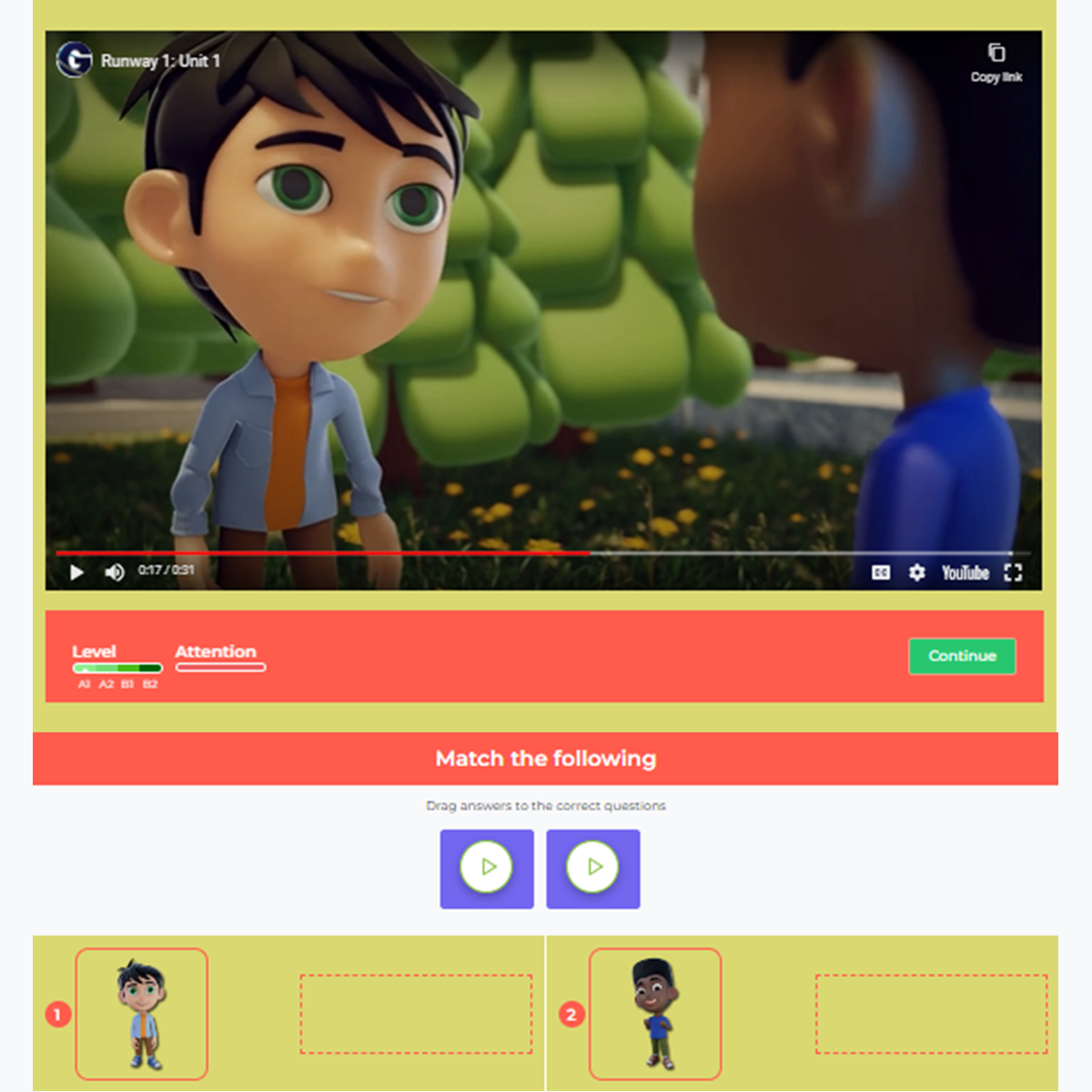
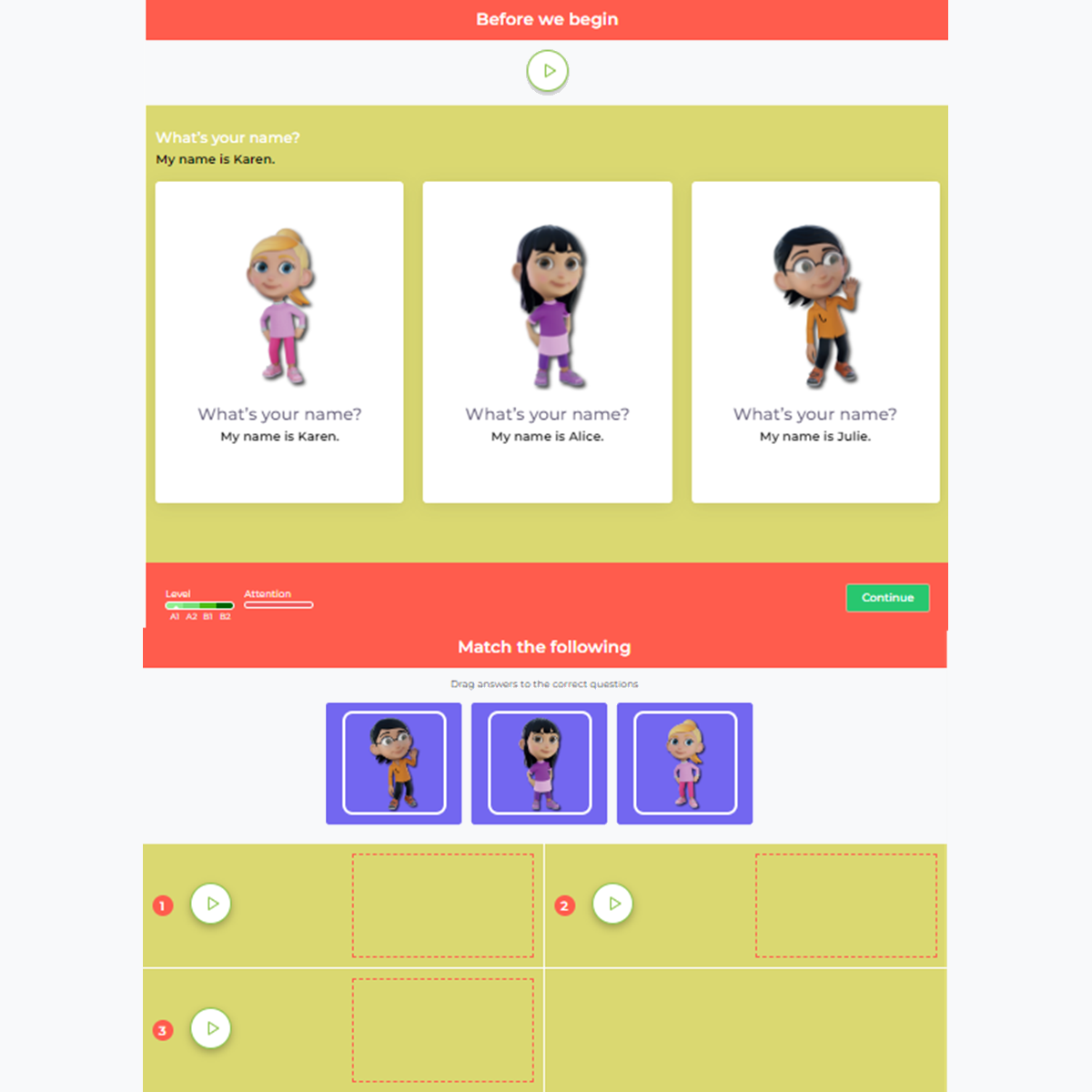
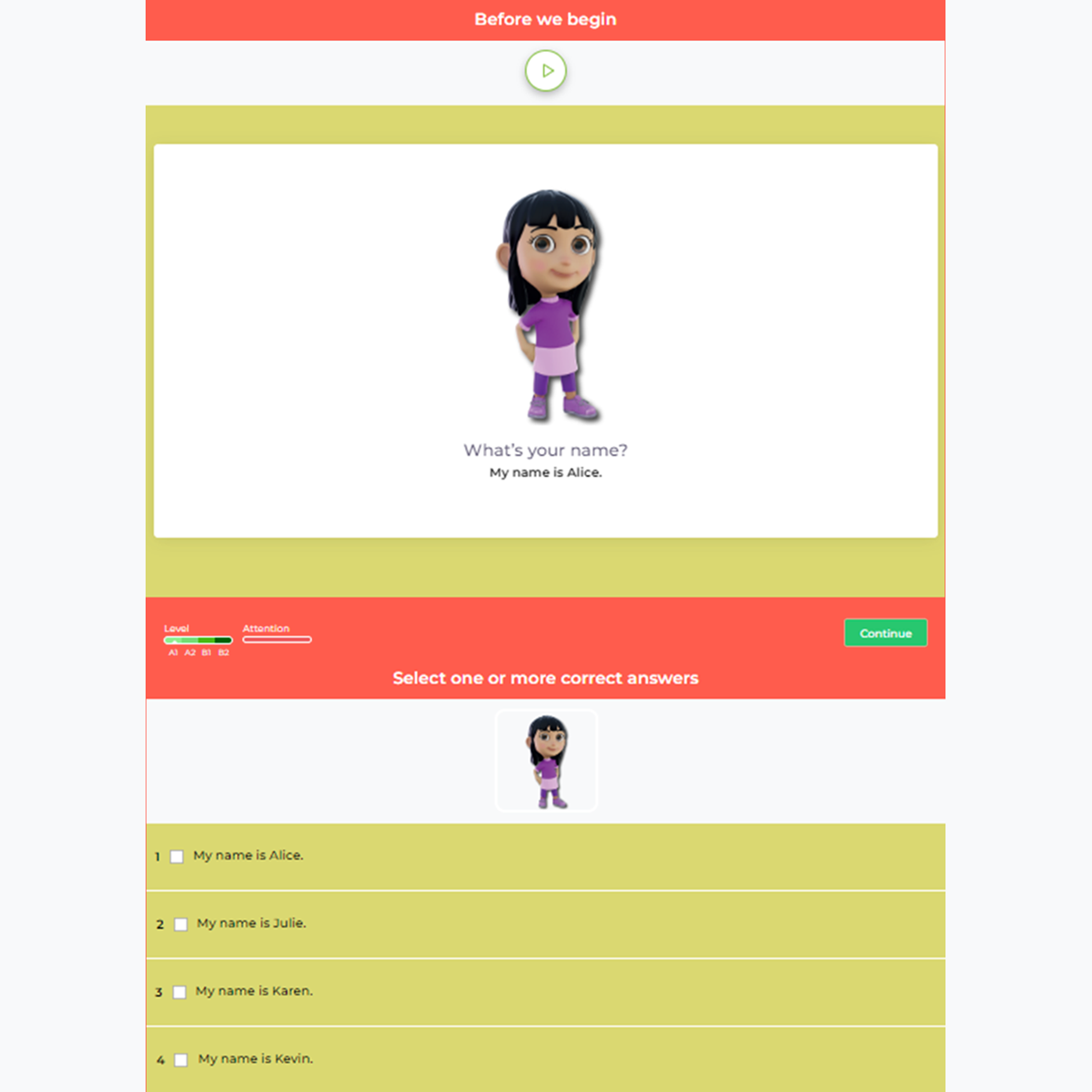
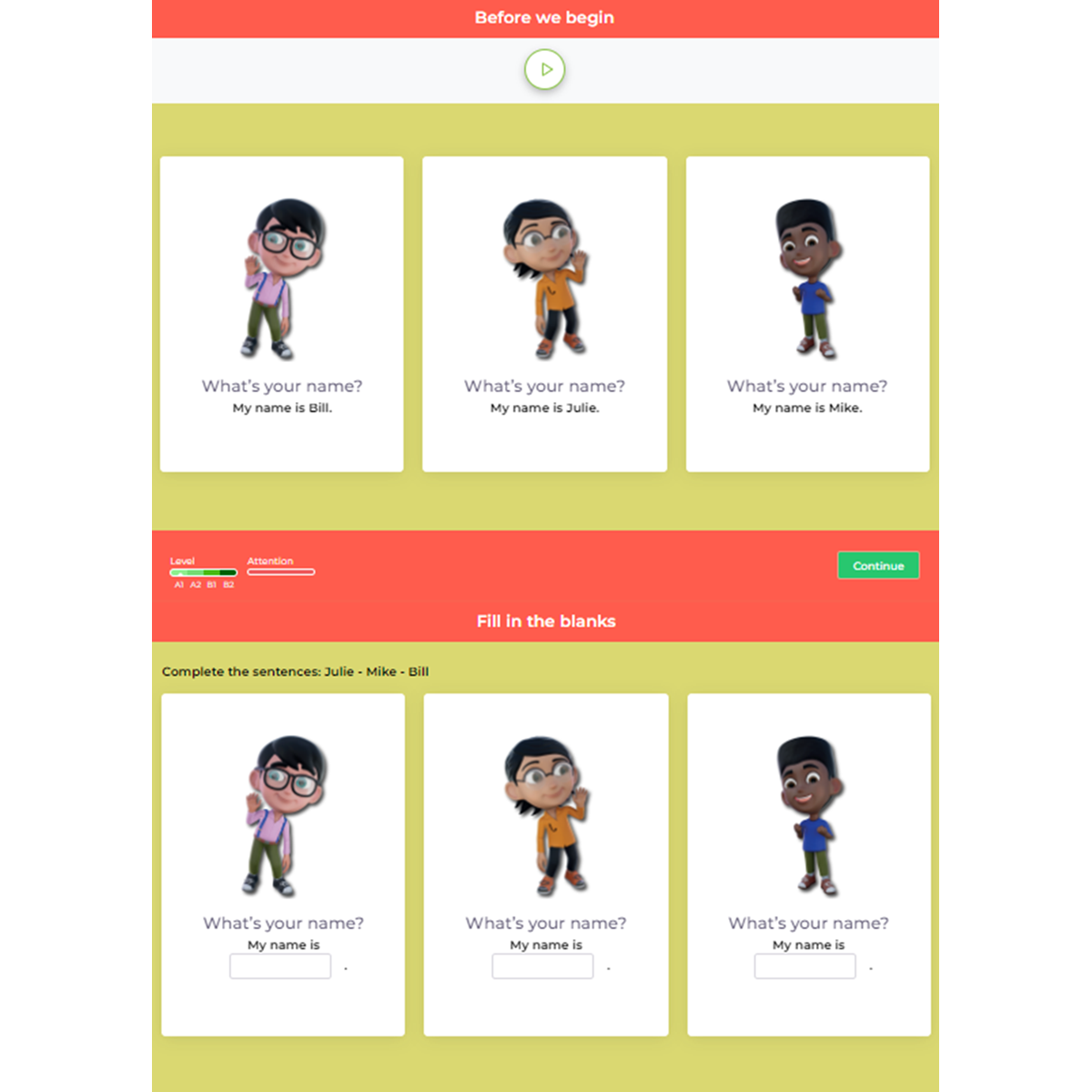
Language Arts
Grammar
Math
Grade 1 English for math is a great introduction to the language of numbers in English.
These math lessons include an animated video to explain the math concept the students are learning. The students will then complete the questions for the lessons in English. Lessons include skip counting, identifying place values, using number lines, and sorting 3-digit numbers.
Try This Lesson
Lesson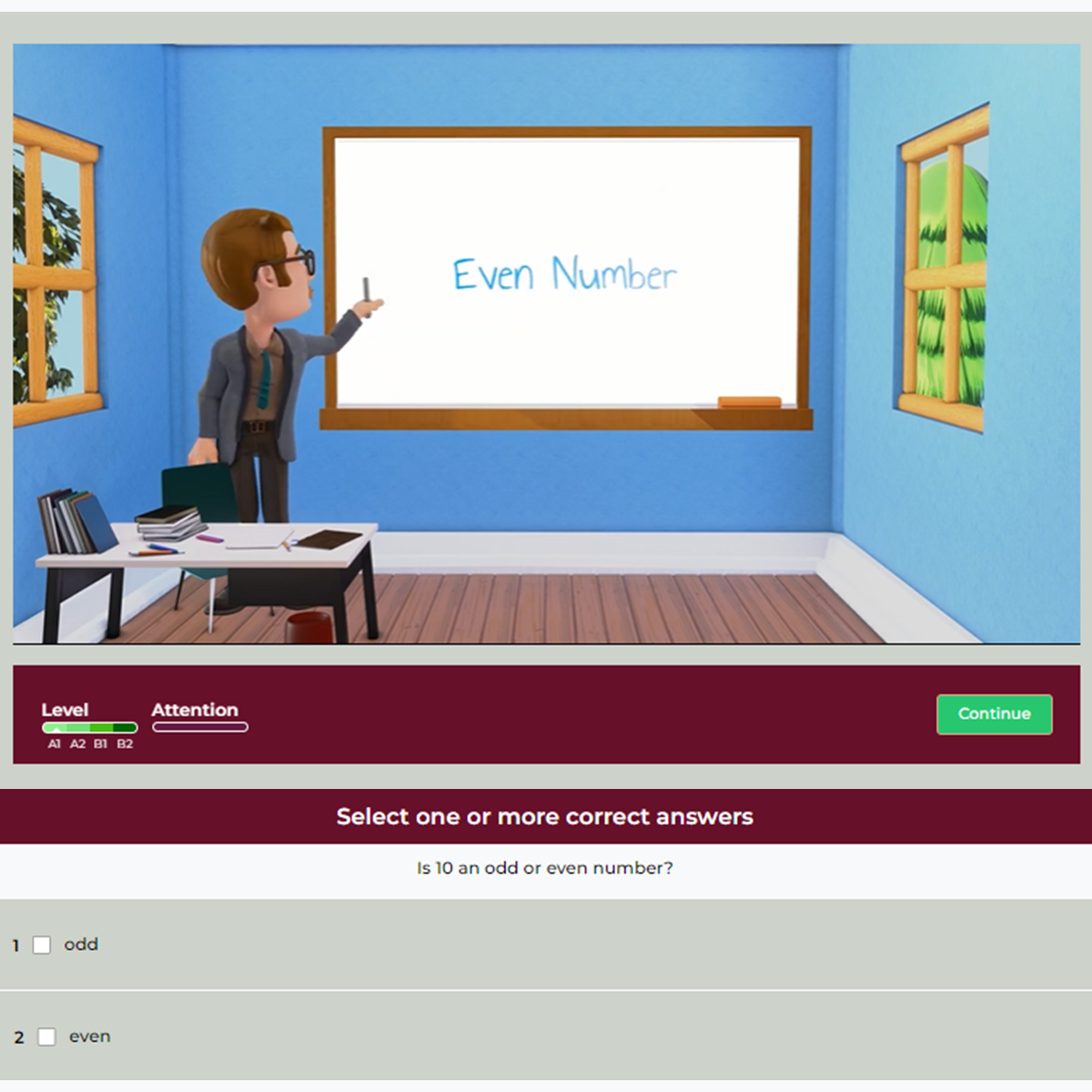
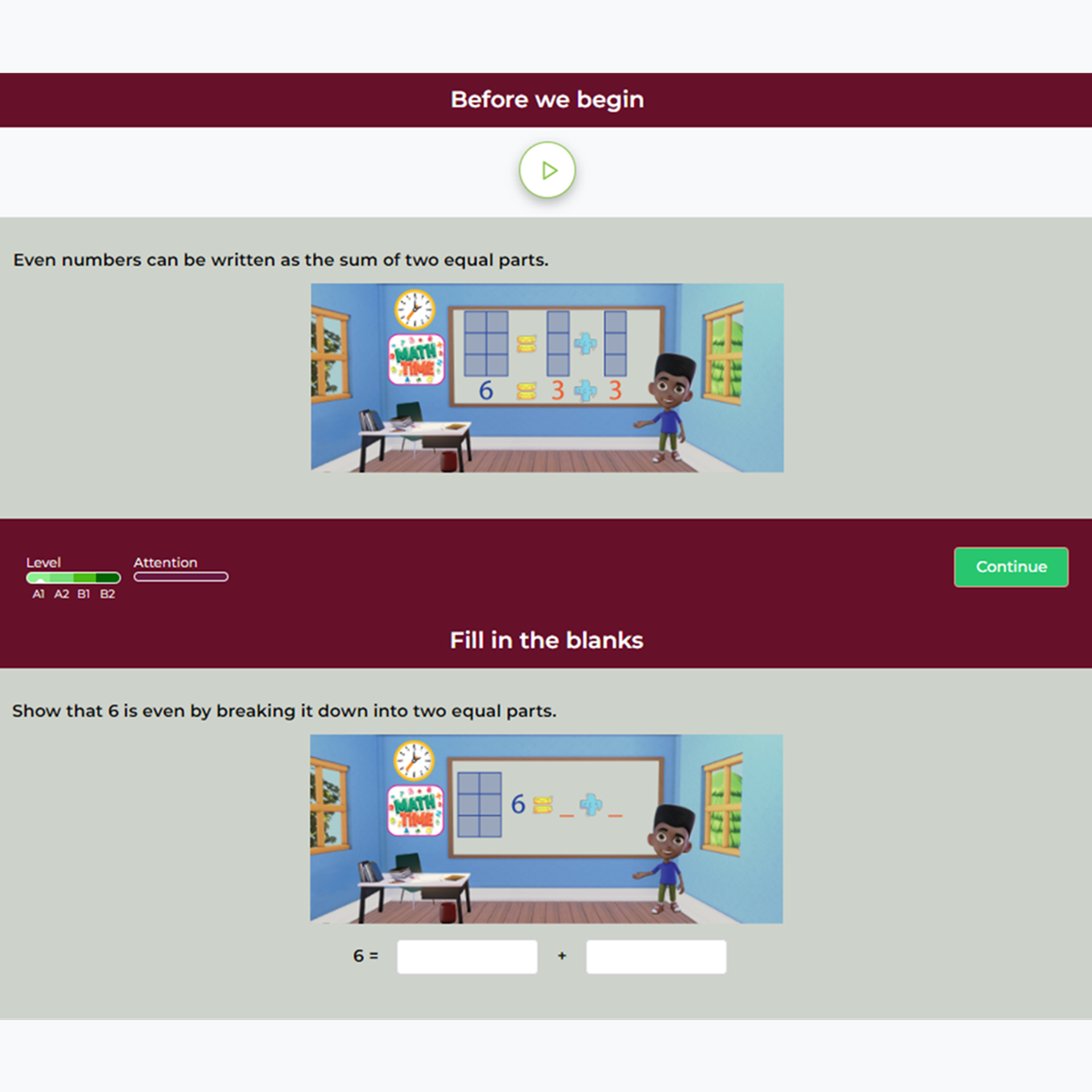
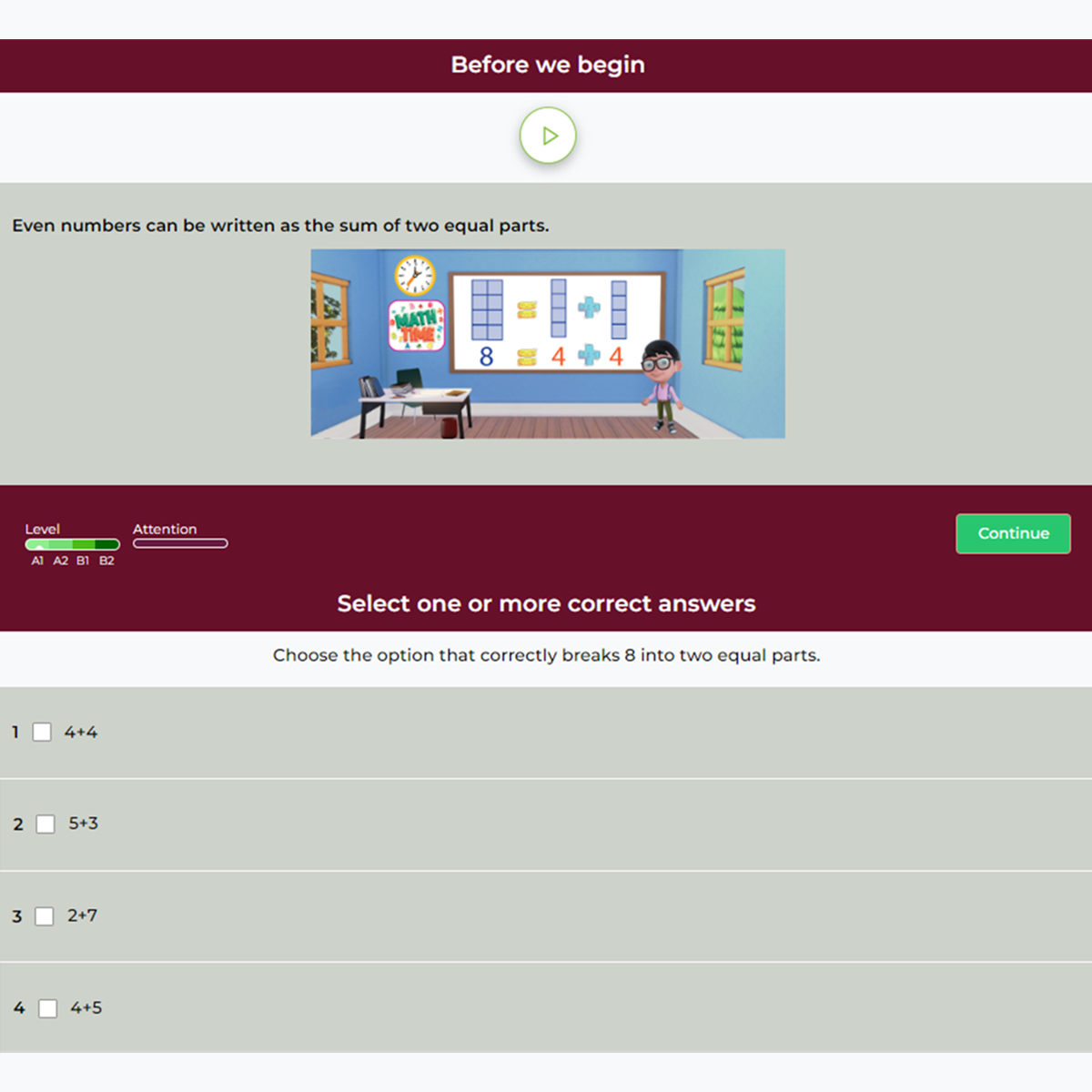

CEFR
Language Arts
Grammar
Math
CEFR
Language Arts
Grammar
Natural Science
Social Science
Math
CEFR
Middle school students need to learn the same English skills that younger students require. There are three main differences though.
1. Older students can learn more skills faster.
2. Older students need more mature topics.
3, Older students need more mature curriculum style, layout and art.
Try This Lesson
Lesson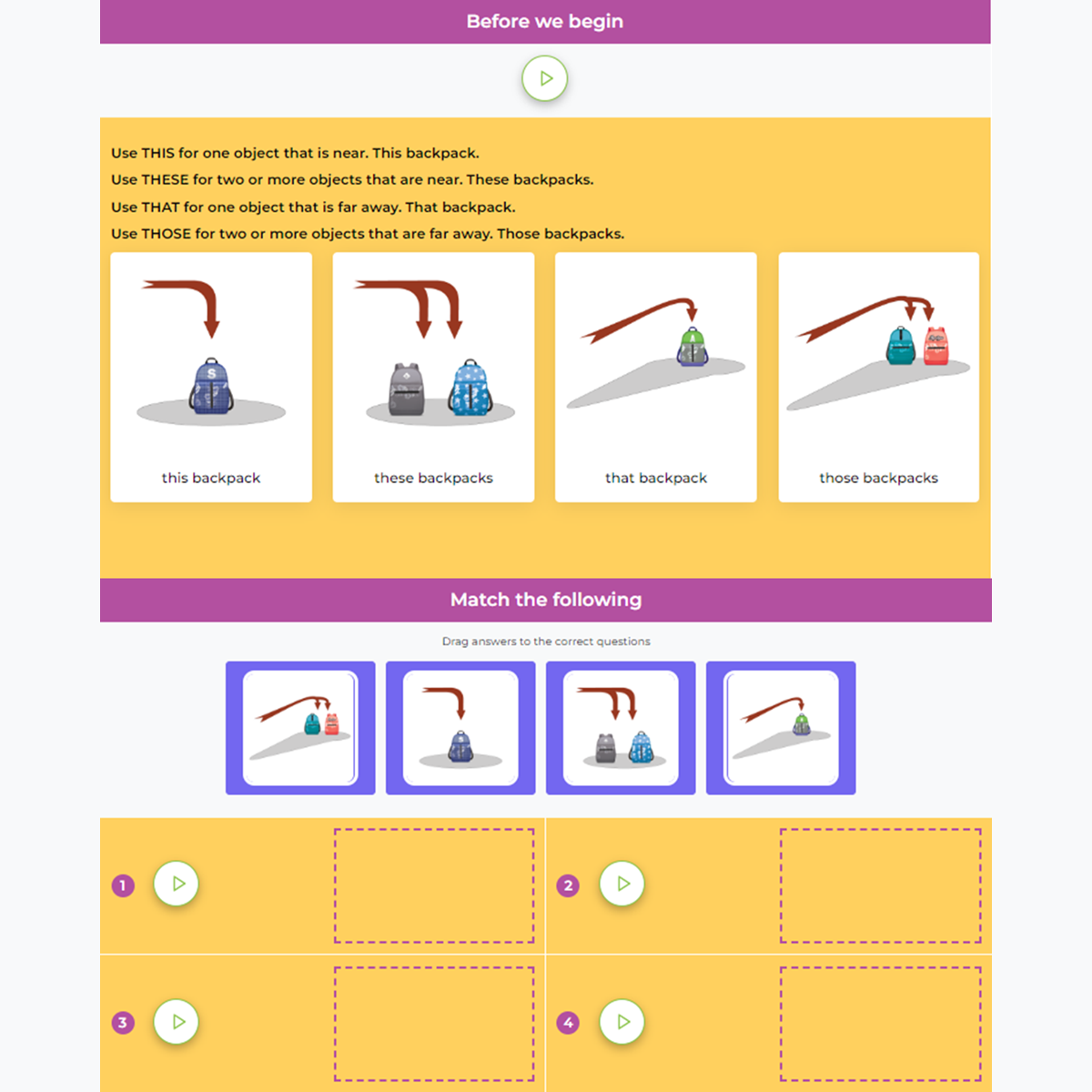
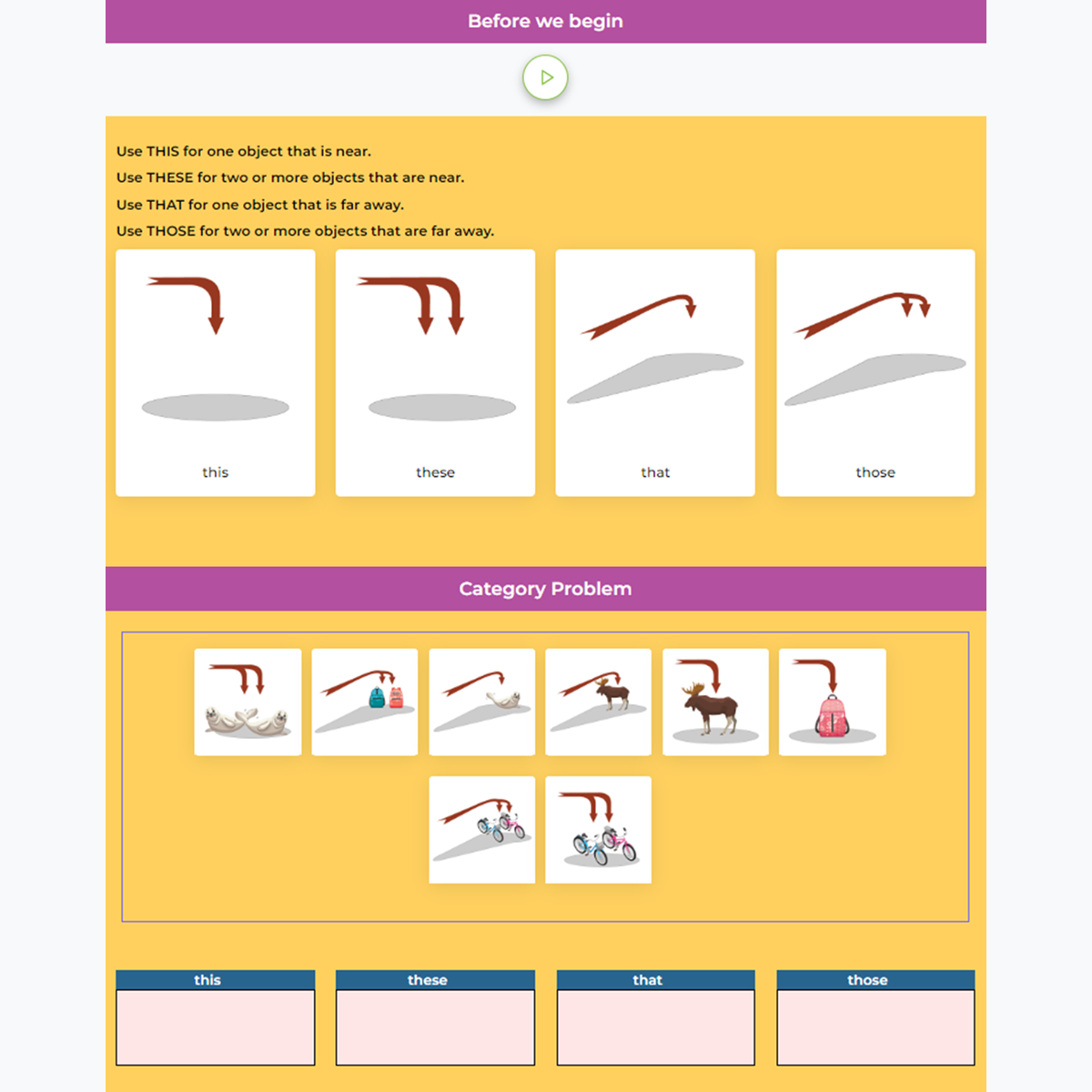
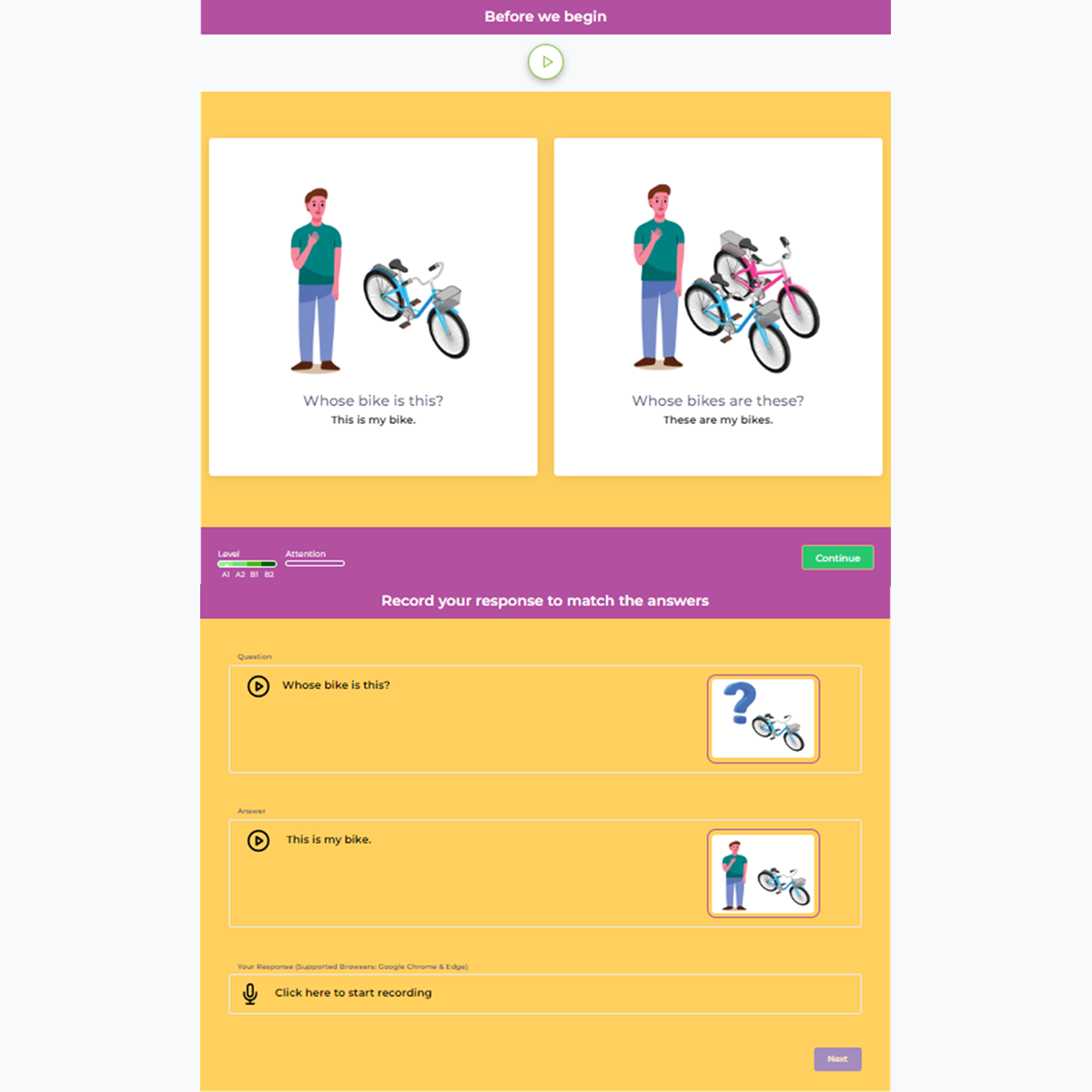
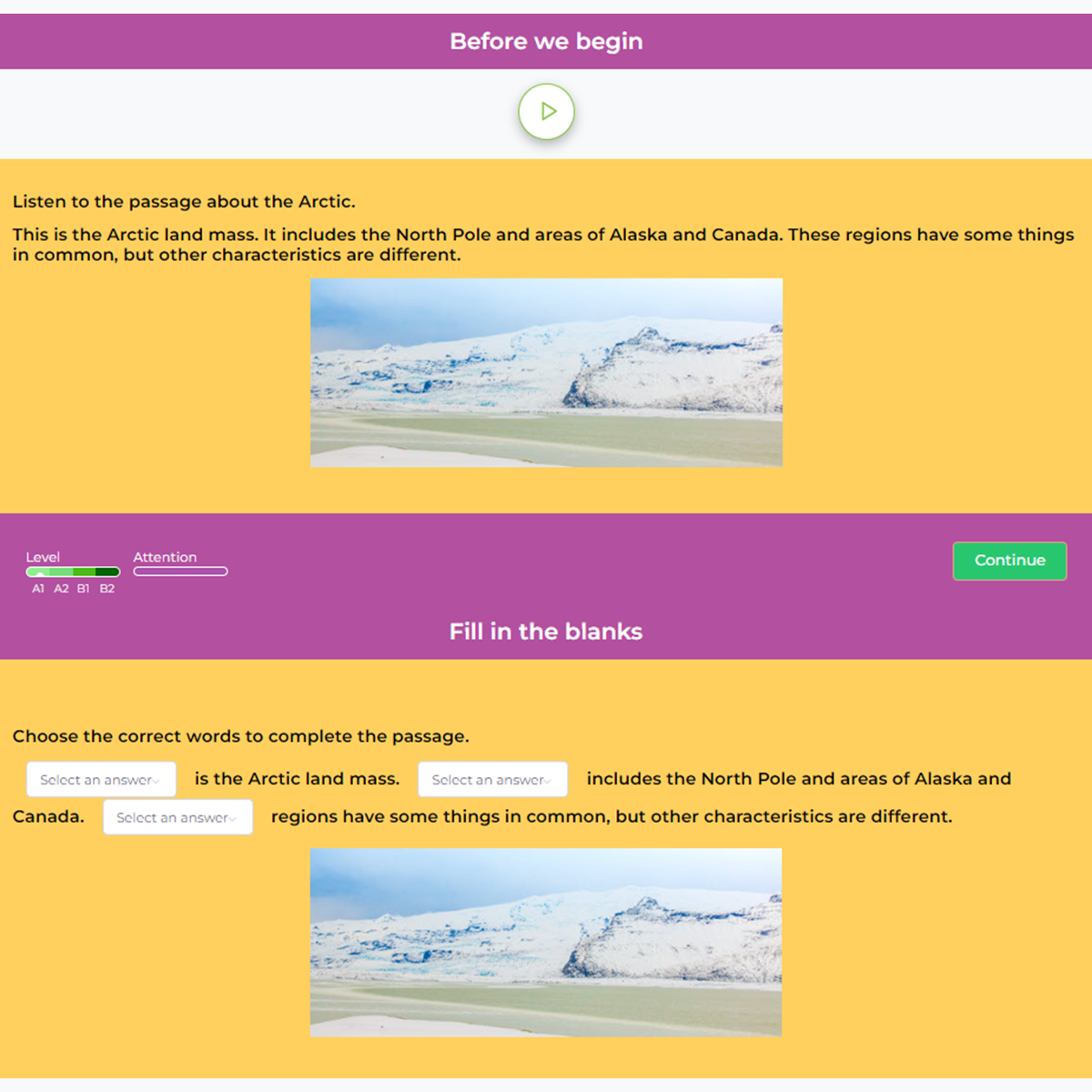
Language Arts
Social Science
Natural Science
Math
Math problems are useful for language training because they are comprised of simple, repetitive questions designed to help student practice a targeted mathematical skill. Also, the vocabulary of math is important for students who wish to acquire academic level English skills.
Try This Lesson
Lesson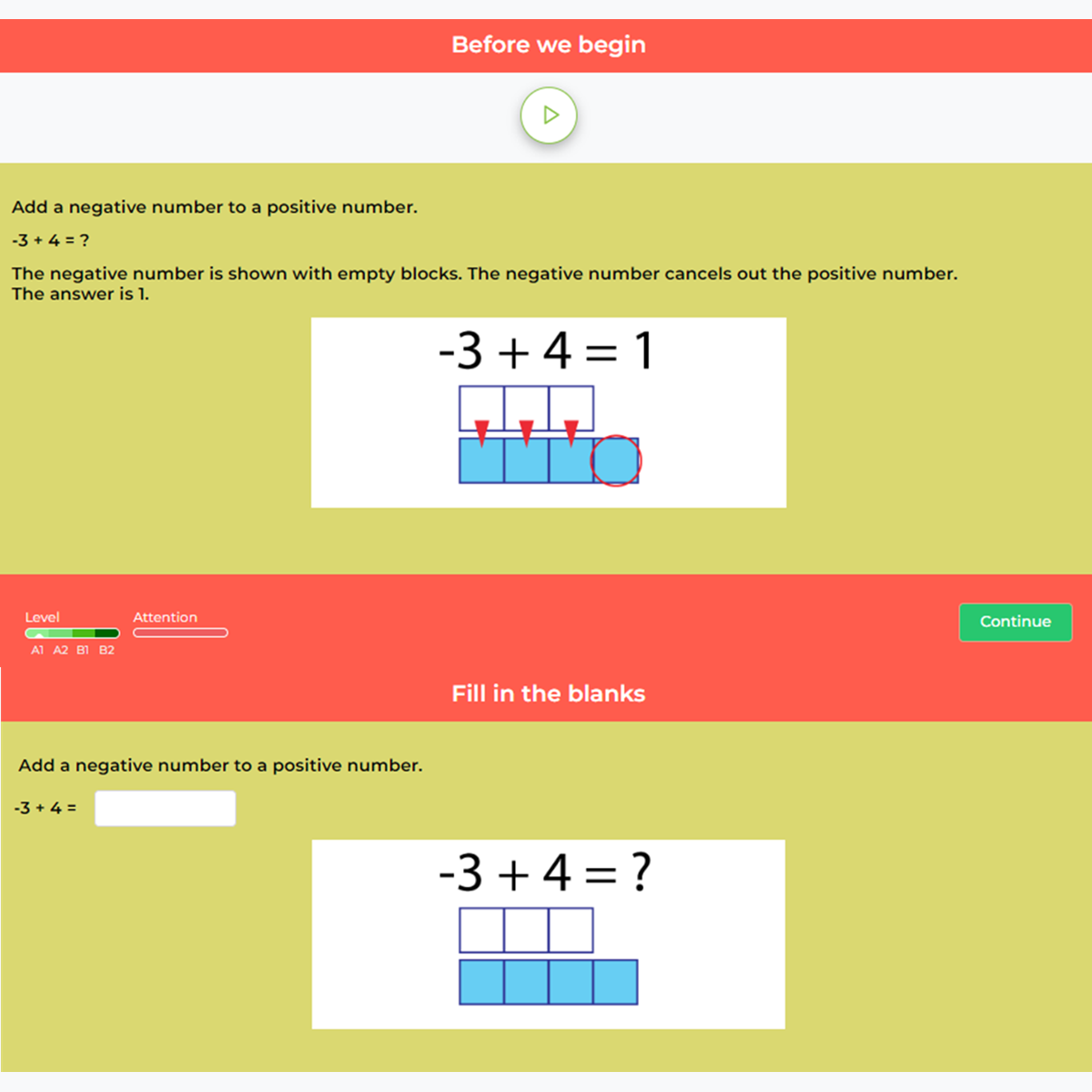
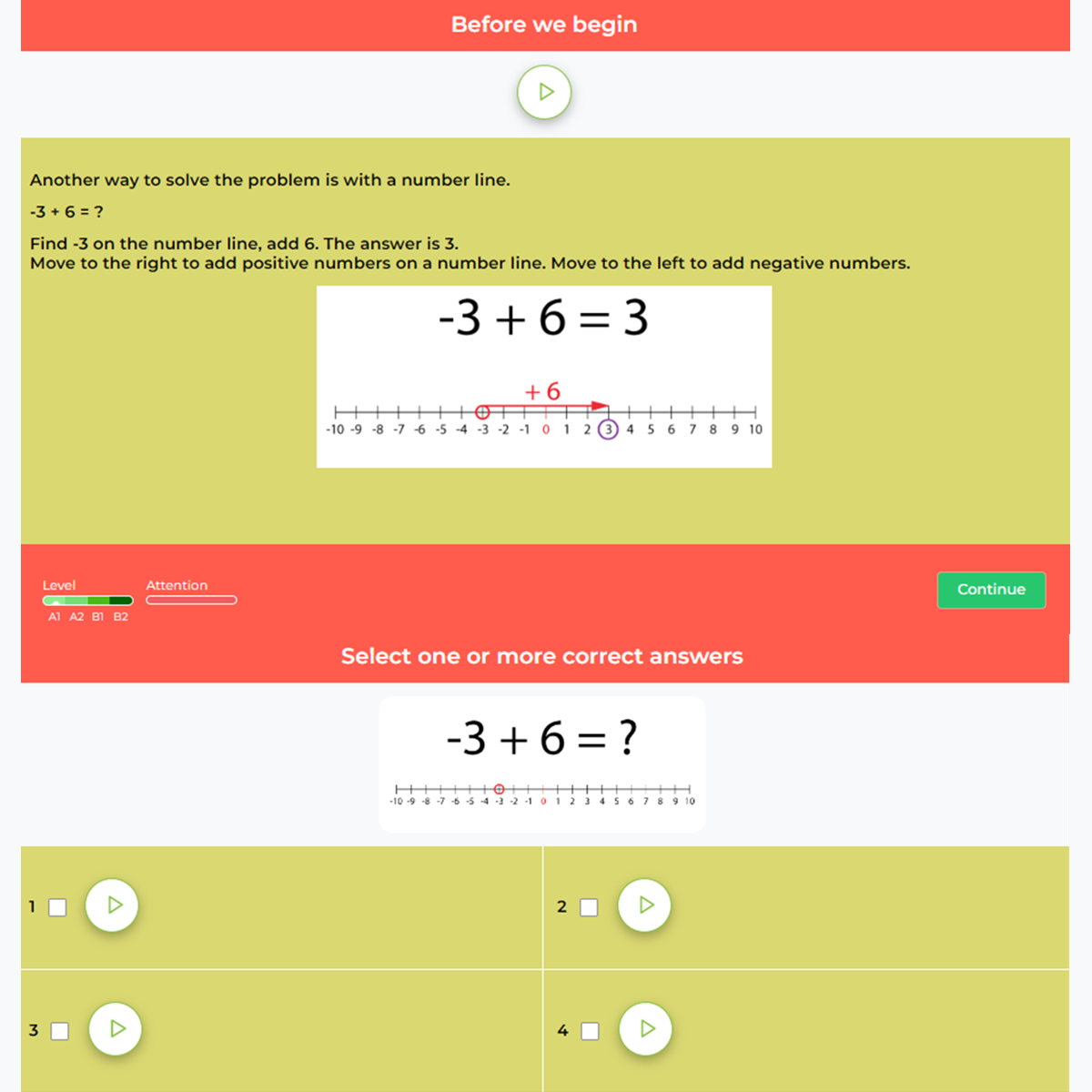
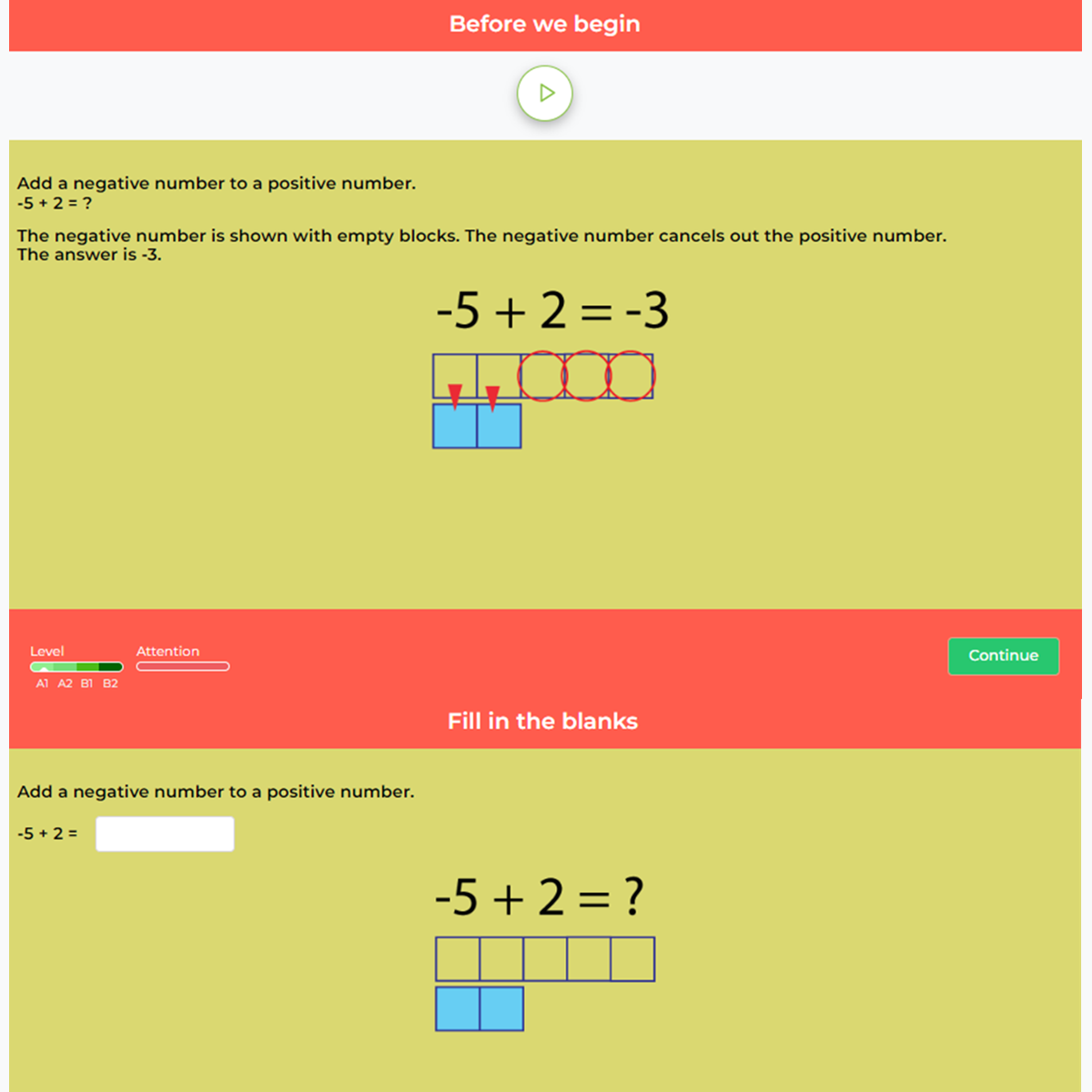
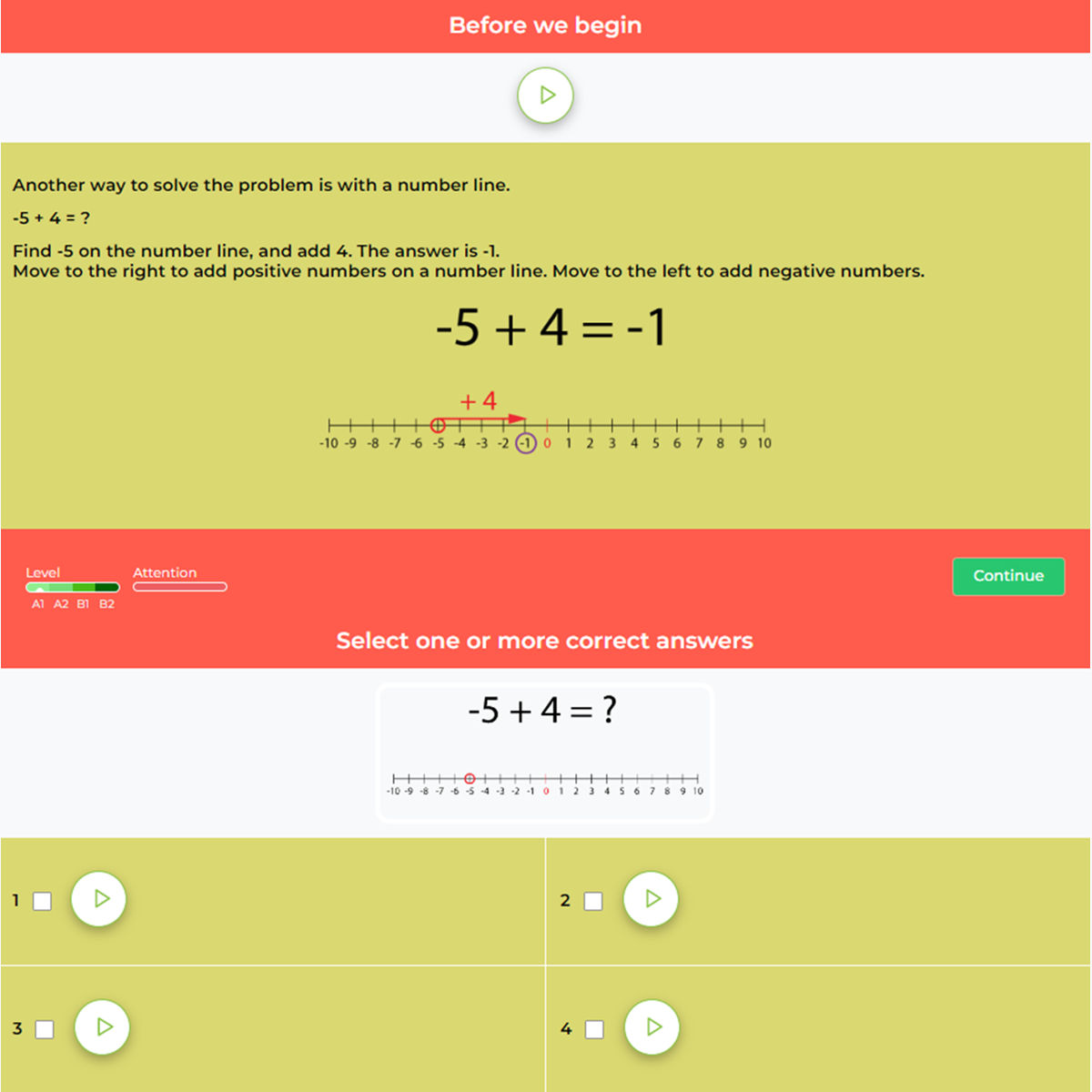
CEFR
Language Arts
Social Studies
Science
CEFR
Language Arts
Social Science
Natural Science
Math
CEFR
At high school levels, student may need to learn CEFR skills on academic curriculum without a dedicated CEFR lesson set. This is often because they are on a short time schedule to acquire academic language skills, so more difficult lesson material and more student dedication is required for more rapid progress.
Try This Lesson
Lesson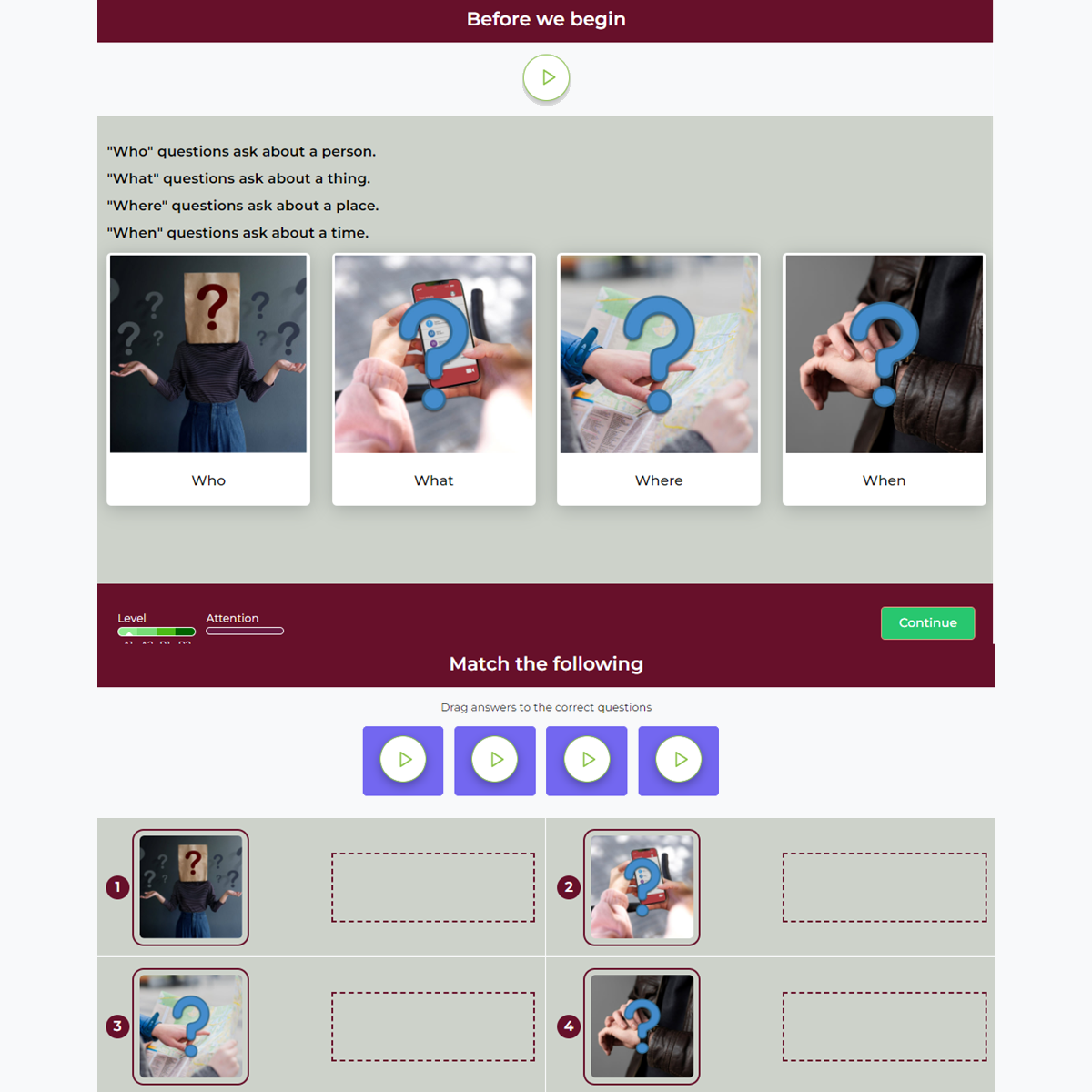
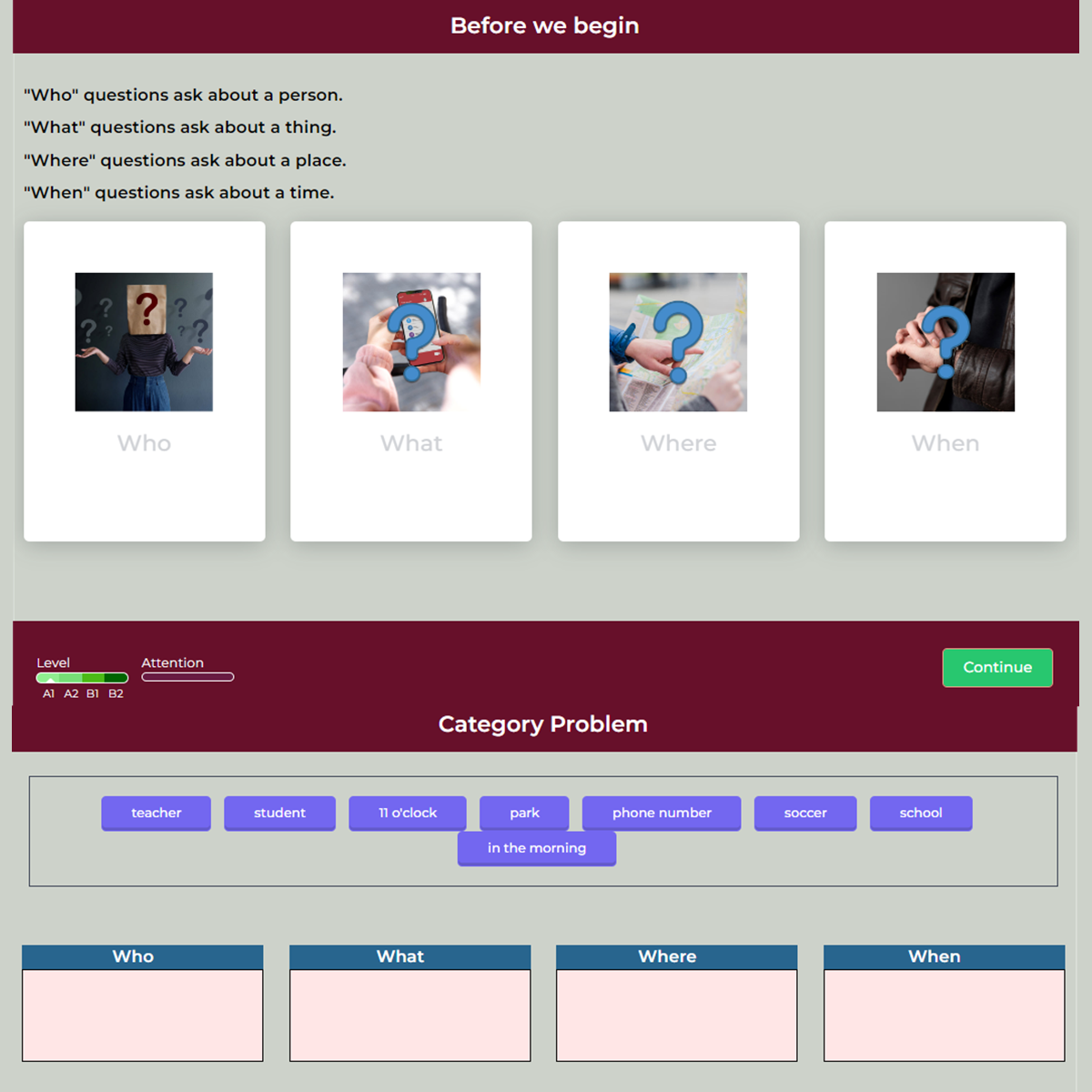
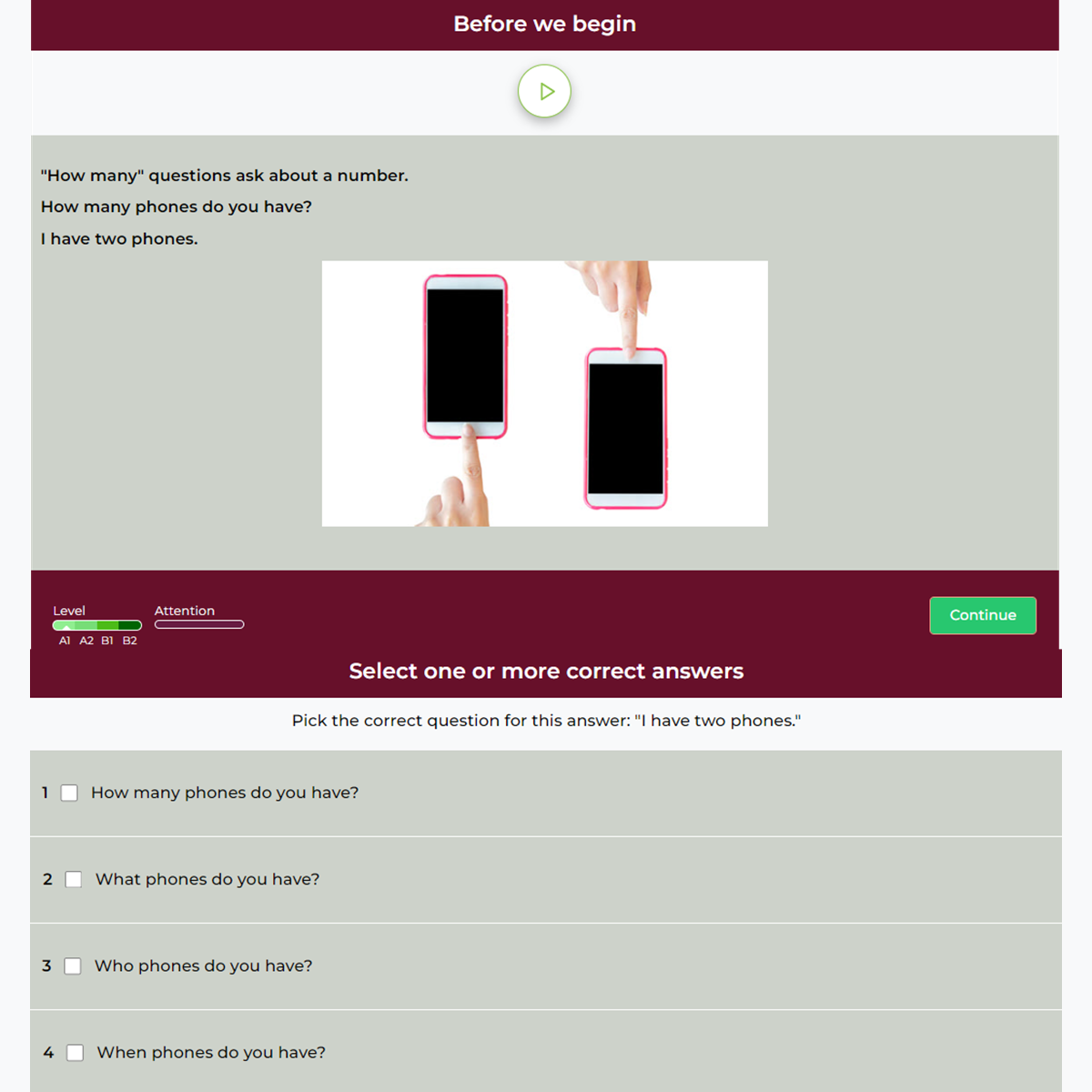

Language Arts
Social Science
Natural Science
Math
Math problems are useful for language training because they are comprised of simple, repetitive questions designed to help student practice a targeted mathematical skill. Also, the vocabulary of math is important for students who wish to acquire academic level English skills.
Try This Lesson
Lesson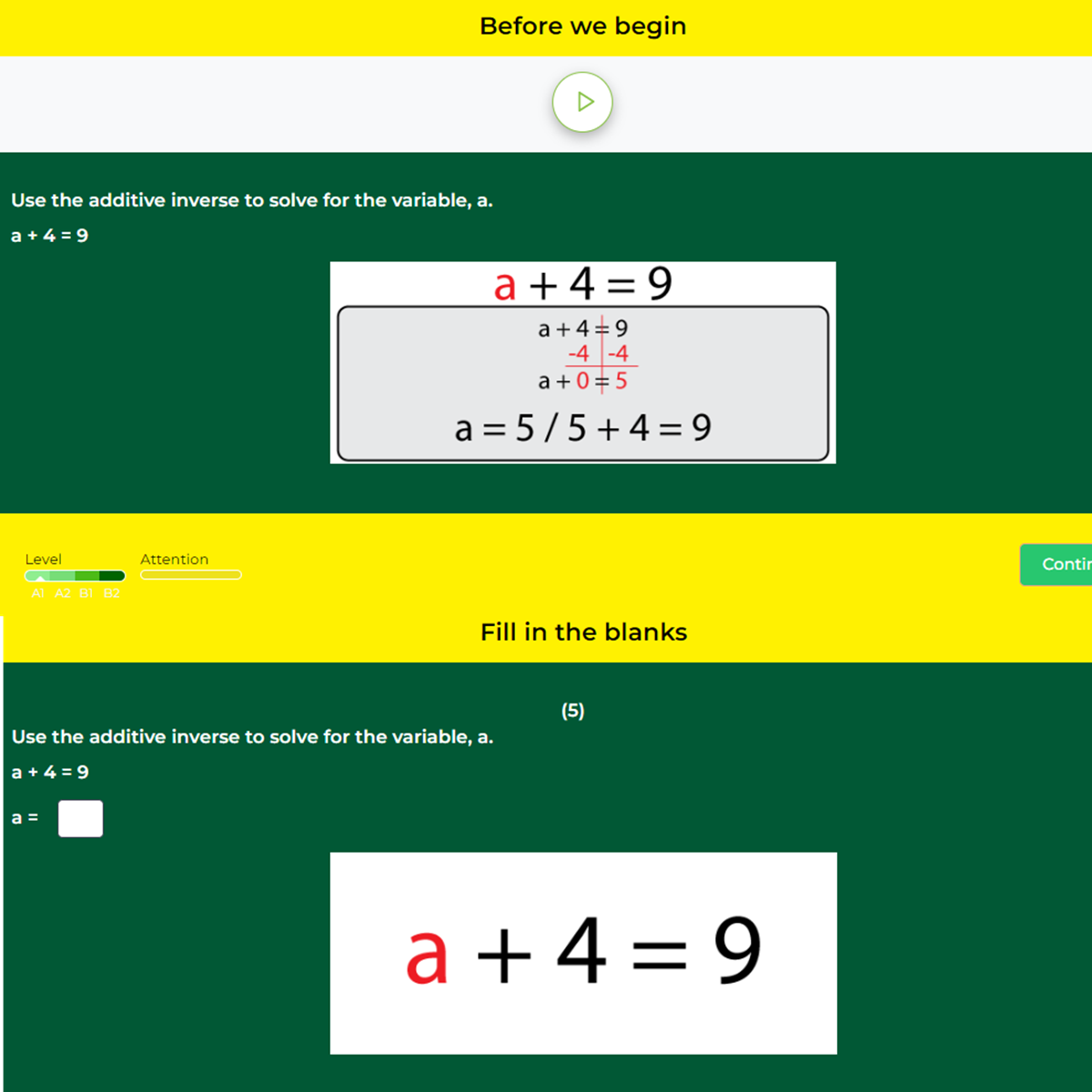
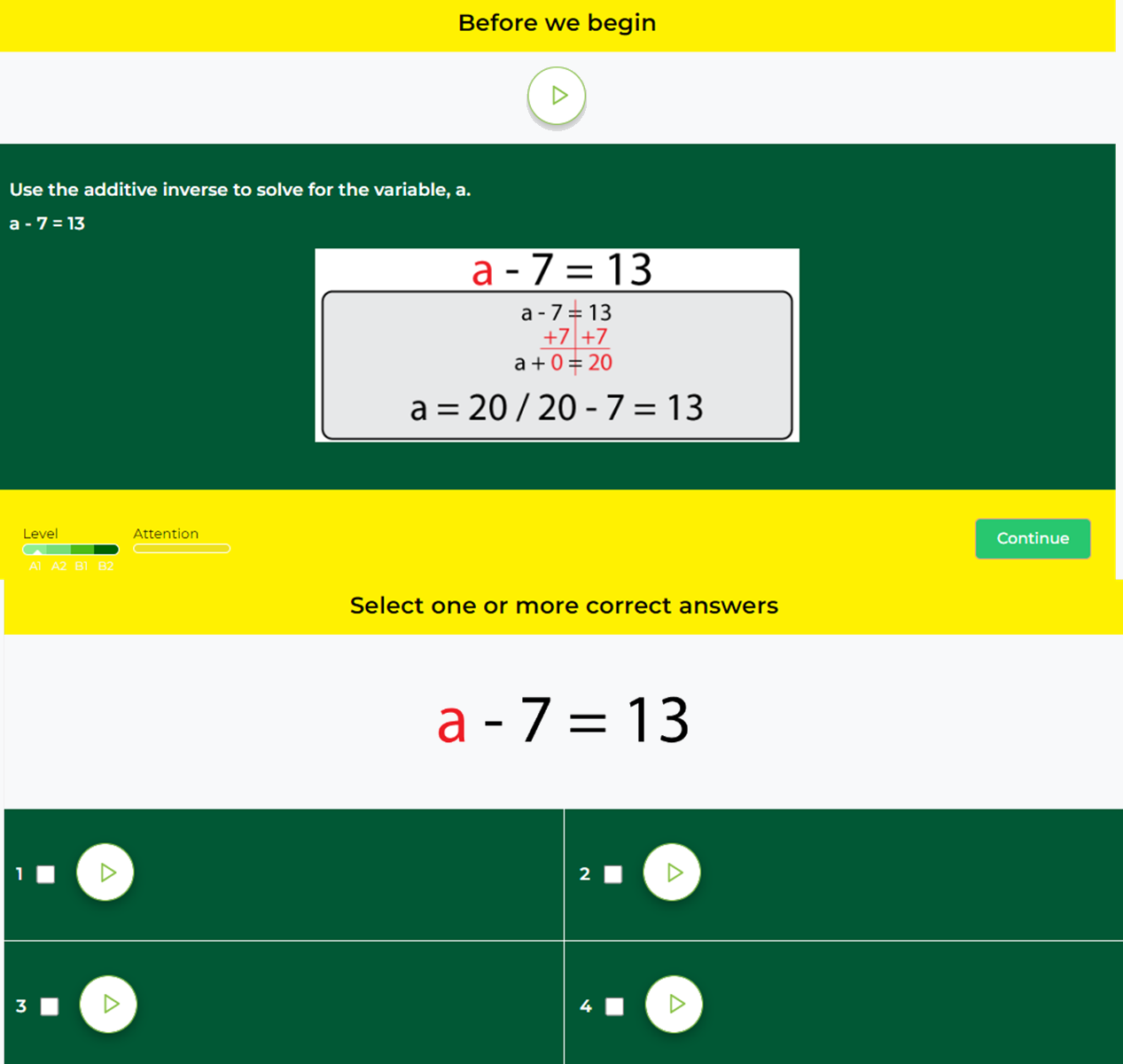

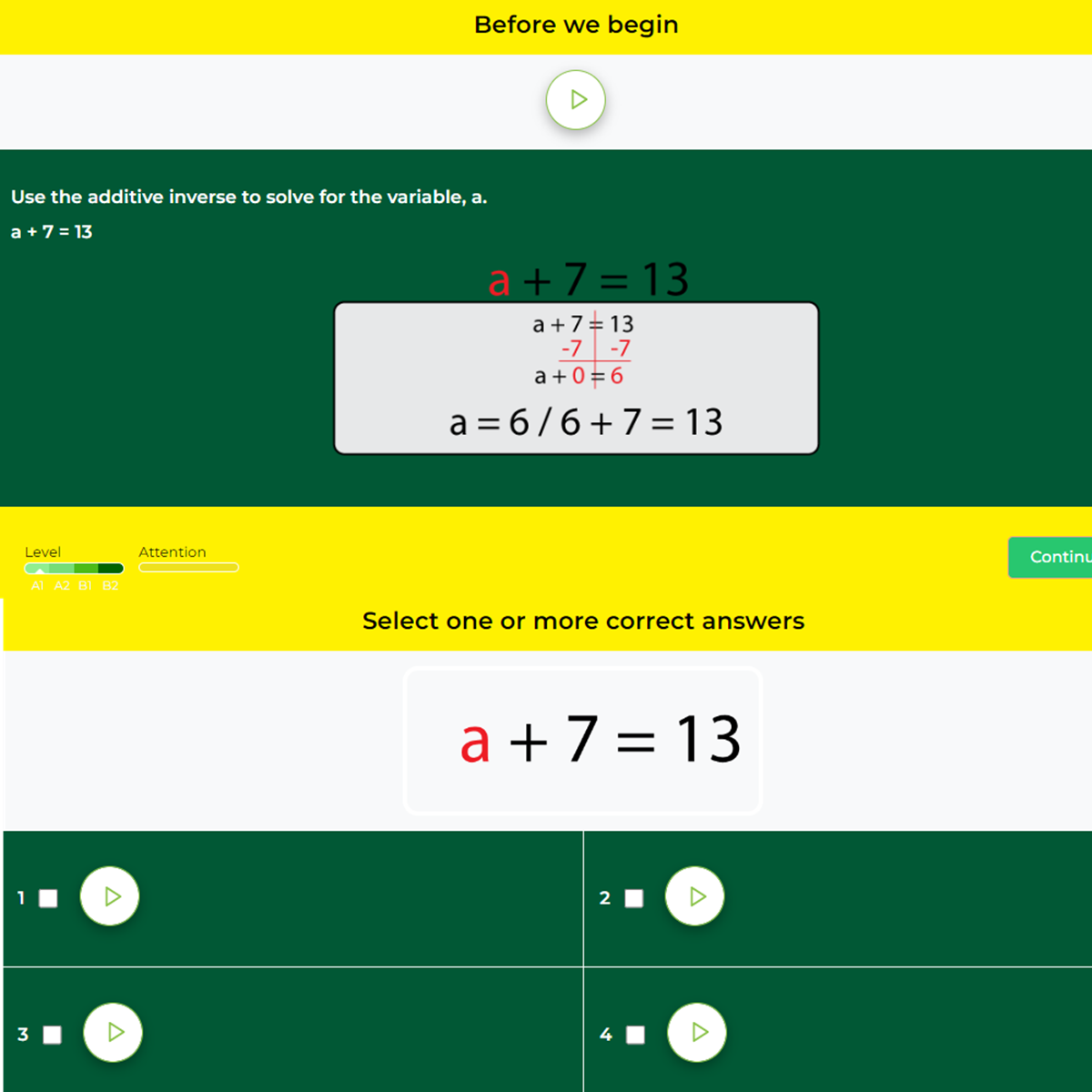
CEFR
Language Arts
Social Science
Natural Science
Math
Transition Year
GEC's Curriculum Strategy
GEC uses CEFR lessons to help establish basic language skills. GEC uses CEFR language standard to assess student language skills up to C2 level. GEC also uses academic lessons in English that are based on US academic standards from all 50 states.
Lesson Sequencing and Pacing
Each grade has default sequencing and pacing based on the assignment calendar. Teachers have the ability to edit the calendar, however, and GEC can customize the default scope and sequence for special programs, or for entire schools or districts for the full school year.
Lesson Assignment Variability
Live Class or Self Study Assignments
All live class lessons have self-study problems, and difficult self-study lessons can be addressed in a live class session as needed. These factors are considered in lesson selection and delivery.
Grade Level Variation
Older students usually have some input skills while younger students do not. Older students congnitively handle higher conceptual difficulty while younger students do not.
CURRICULUM DETAILS
Elementary
CEFR lessons help students learn functional conversation skills before moving to academic topics.
Grade 1 English for Language Arts includes alphabet and phonics lessons focusing on both academic and language skills at the same time.
Grade 1 English for grammar includes basic grammar skills lessons focusing on both academic and language skills at the same time.
Grade 1 English for Math includes basic numbers, arithmetic, geometry, and measurement lessons focusing on academic and language skills simultaneously.
Middle School
GEC has hundreds of lessons on CEFR topics as primers for students whose language skills are too low for them to take on the harder academic lessons.
Grade 7 English for Language Arts includes lessons covering topics on figurative and descriptive language, vocabulary strategies and usage, formal and informal language, and reference materials. All lessons are leveled A1, A2, B1, and B2 to match the English ability of each student.
Grade 7 English for Social Studies is comprised of lessons covering topics in cultures and communities, geography, economics, history, and study skills. All lessons are leveled A1, A2, B1, and B2 to match the English ability of each student.
Grade 7 English for Natural Science includes lessons covering topics in human body systems, ecology and the environment, Earth’s surface and structure, and motion, forces, and energy. All lessons are leveled A1, A2, B1, and B2 to match the English ability of each student.
Grade 7 English for Math includes ratios, equations, geometry, and statistics lessons focusing on academic and language skills simultaneously.
High School
GEC has hundreds of lessons on CEFR topics as primers for students whose language skills are too low for them to take on the harder academic lessons.
Grade 10 English for Language Arts includes lessons covering topics on figurative and descriptive language, vocabulary strategies and usage, formal and informal language, and reference materials. All lessons are leveled A1, A2, B1, and B2 to match the English ability of each student.
Grade 10 English for Social Studies is comprised of lessons covering topics in cultures and communities, geography, economics, history, and study skills. All lessons are leveled A1, A2, B1, and B2 to match the English ability of each student.
Grade 10 English for Natural Science includes lessons covering topics in cells and heredity, space, chemistry, technology, and engineering. All lessons are leveled A1, A2, B1, and B2 to match the English ability of each student.
Grade 10 English for Math includes exponents, equations, geometry, and statistics lessons focusing on academic and language skills simultaneously.
Specialized
GEC's language test prep courses offer comprehensive preparation for CEFR and Eiken exams through both linear and adaptive placement tests. With thousands of practice questions available in our extensive question banks, students can effectively tailor their study plans to enhance their skills and con dently tackle their language assessments.
GEC Travel English is designed for students heading abroad to study English, offering tailored programs in cities like Boston, Singapore, Sydney, and Vancouver, with new destinations frequently added. The curriculum focuses on practical language skills for travel, including destination-specific topics and CEFR skills training, ensuring students are well-prepared to navigate their studies and experiences in their chosen locations.
GEC offers Adult English programs tailored for Business and Nursing professionals looking to enhance their English skills. The Business program emphasizes conversation, presentations, meetings, and interview techniques, while the Nursing program provides a comprehensive study focused on the specific language and terminology used in the nursing field.